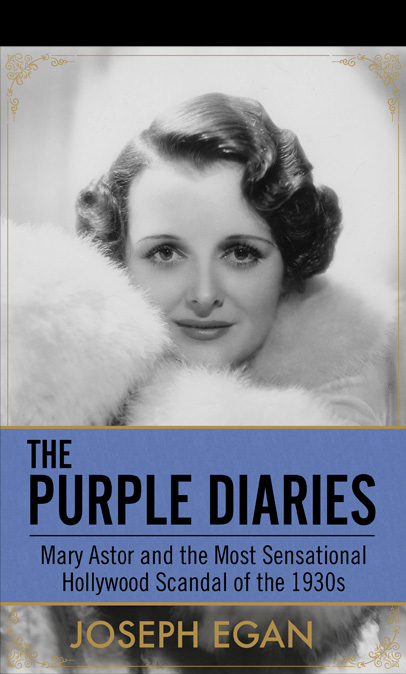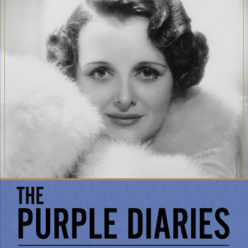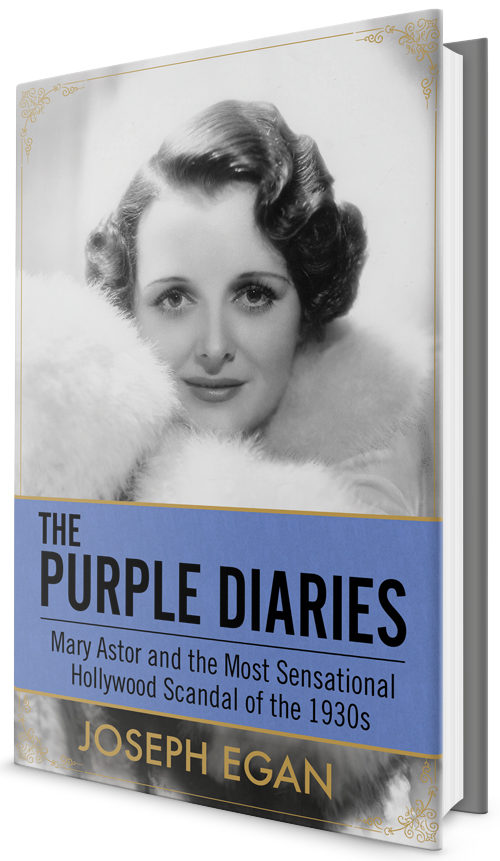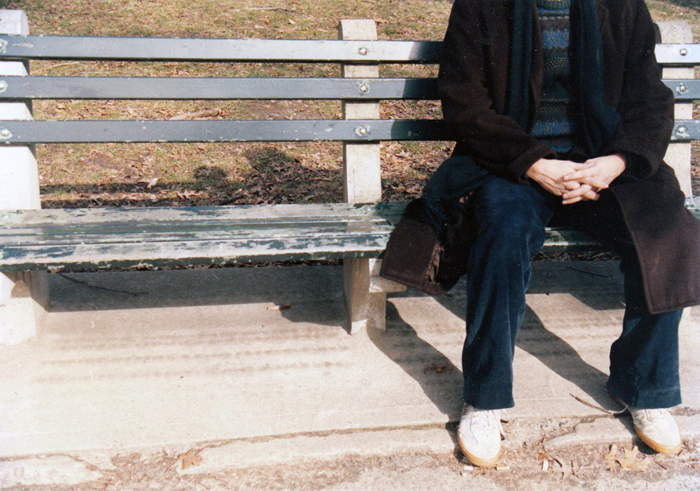


http://silverscreenoasis.com/oasis3/index.php
This Interview is excerpted from an open Forum conducted by the Silver Screen Oasis Website from January 20 thru 22, 2017 and is posted here with special permission from The Silver Screen Oasis Administrators.
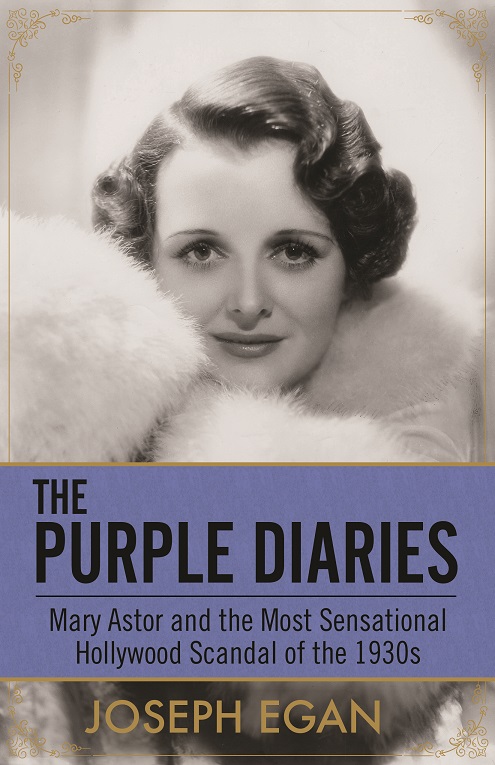
JOSEPH EGAN DISCUSES THE PURPLE DIARIES
In “The Purple Diaries Writer” Joseph Egan has written a fascinating and meticulously researched book on the famous 1936 Mary Astor Custody Battle. In this interview Mr. Egan discuss the famous court case, Mary Astor’s life and the reasons why he wrote his book.
QUESTION-In an odd twist of fate, another Mary Astor book about the Custody Battle was published ONE MONTH before your wonderful book, “The Purple Diaries.” Would you tell us in a nutshell what that other Mary Astor book concerns and briefly detail how your book is different from the earlier book?
ANSWER-It’s a completely different book. These differences are best described in this excerpt from a post on my blog. Edward Sorel, the award winning caricaturist has written a satirical look at the 1936 Mary Astor Custody Battle—“Mary Astor’s Purple Diary.” But, it should be understood that Mr. Sorel has not written a ‘history.’ The book is more in the nature of a ‘tale tail’ that Mr. Sorel cleverly weaved into a screwball comedy plot popular in films of the late 1930s. Consequently, as with all satire, historical accuracy is not an issue because, like his caricatures, Mr. Sorel is aiming for another kind of truth. Over the years the Mary Astor Custody Battle transformed from fact into legend and it is this legend which Mr. Sorel mirrors in his light-hearted and humorous send-up. Peppered throughout its 176 pages are a series of Sorel illustrations; among his very best Hollywood caricatures. They capture a surreal, almost impressionist view of the people and events chronicled in his book which stylistically augment and enhance the text.”
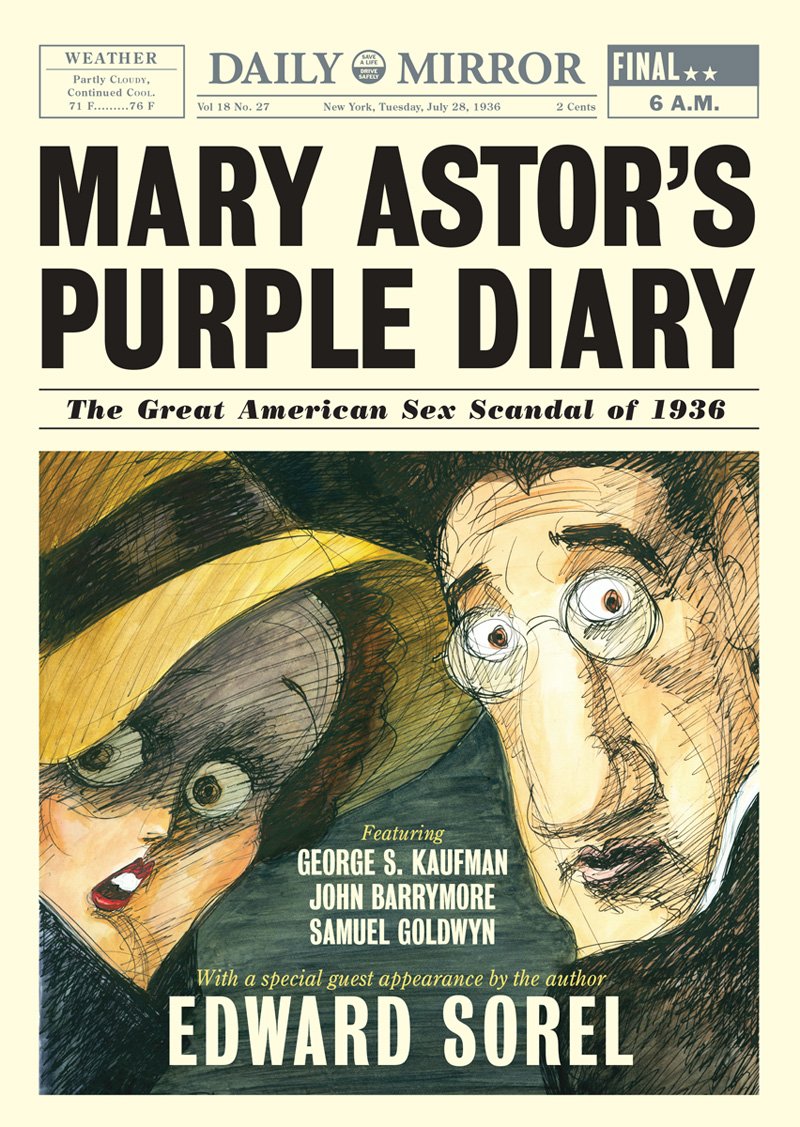
My book —“The Purple Diaries” unlike Sorel’s book, is a “history: and not a send-up.” It is a thoroughly researched and objective view of Astor Custody Battle. Filled with photographs and not caricatures it was written to correct the innumerable inaccuracies set down over the past 80 years regarding this story—inaccuracies that have generally been accepted as fact. Consequently, the two books couldn’t be more dissimilar. A friend put it this way: “Edward clearly loves Astor in the way that you do as a fan who wants to see her story told in the medium he best knows how to tell it. You, in a work of non-fiction and Edward in an illustrated interpretation of a mythic event. His reads like a wistful memoir, almost dreamlike, and yours feels ‘hot off the presses’, and very now.” Read together the two books provide the complete story—the truth and the myth and legend that blossomed from it.”
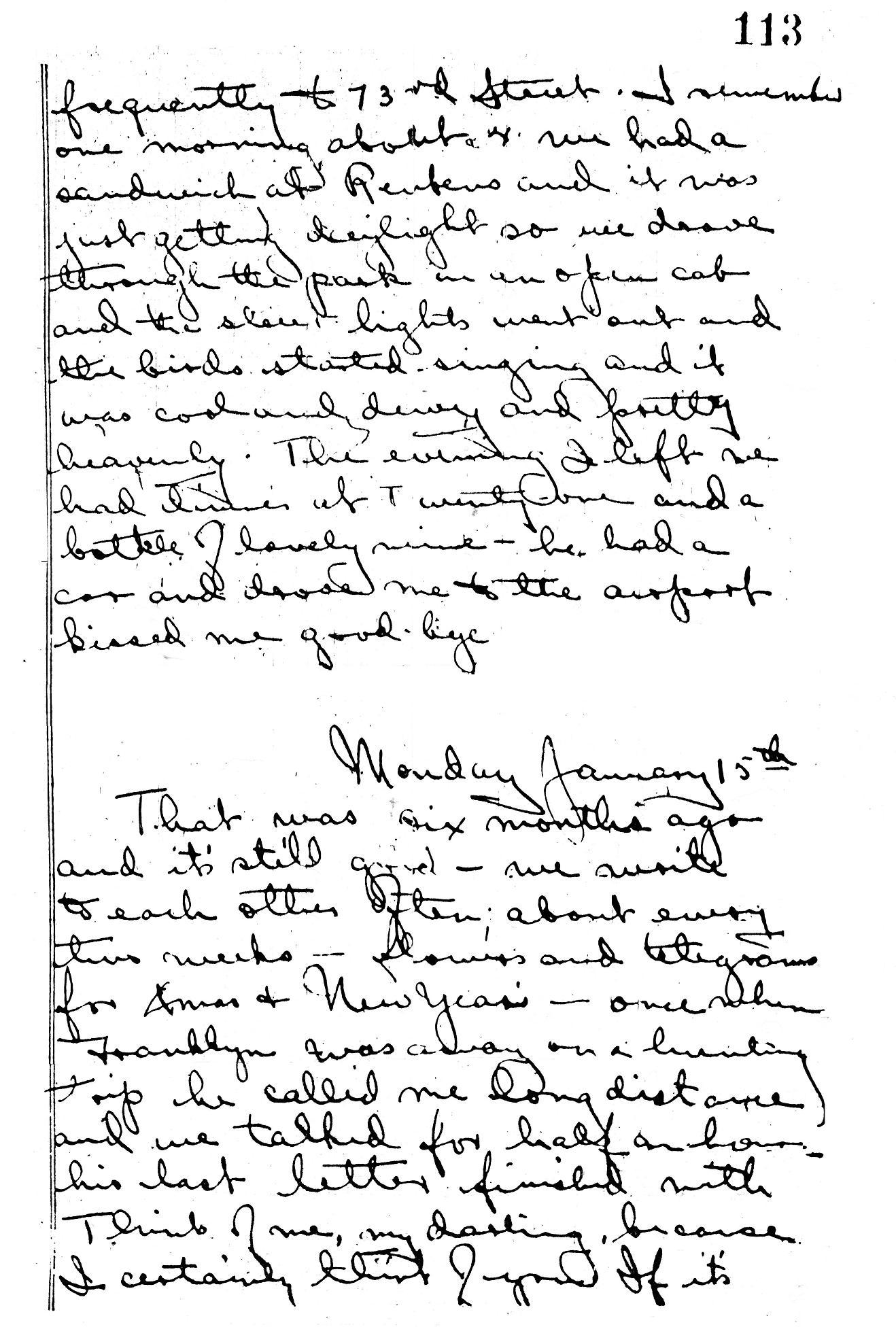
PAGE FROM MARY ASTOR’S PURPLE DIARIES
Q-I haven’t read your book yet, but I was under the impression the original diary was destroyed. Were all the purported excerpts just made up by the press? Did any part of the diary survive in evidence?!
A-I will have to answer that question in several parts. The original diary which was sealed by the court in 1936 was burned a few months after Marylyn turned 21. It was sealed in case the custody case was re-opened. Franklyn Thorpe, who Mary Astor was suing for custody wanted to make sure that if the case was reopened he could use it. Astor wanted to make sure that it couldn’t be used against her or the friends whose activities were discussed in it. When Marylyn turned 21 Astor and Thorpe had a discussion about what to do with it and both agreed that it should be destroyed which was done by the court when it was incinerated.
The only excerpts from the real diary were those in the Answer filed by Thorpe in July 1936 to Astor’s petition and the Kaufman excerpts his attorney released to the press on August 10, 1936 and were printed in newspapers all over the world. (If you go to the purplediaries.com and click excerpts you can read these excerpts.) Everything else printed in the press about scorecards and all that were from a salacious forgery by someone who, according to Mary Astor, was worried that his name might be mentioned in the real diary and so wanted to scare Astor into settling the case. Over the years bits and pieces of this salacious material were printed in articles and books and it was thought that this had come from the real diary which had nothing pornographic or salacious in it. One of the reasons why I wrote the book was to clear this up and finally tell the real story.
The Diary was never submitted as evidence as one of the two volumes had been taken apart so that Thorpe could make Photostats. Astor’s attorney found case law that made it clear that an altered, mutilated or incomplete document could not be used as evidence and in this way prevented it from ever being used in court. Thorpe’s attorney in desperation gave the Kaufman excerpts (on my website) to the press and then asked Astor questions on the stand relating to it so that if she lied about anything written in the diary she could be brought up on perjury charges. It was at this point that the judge had had enough and called a halt and demanded that Astor and Thorpe work out a Custody agreement which they did and he then signed. That took another three days.
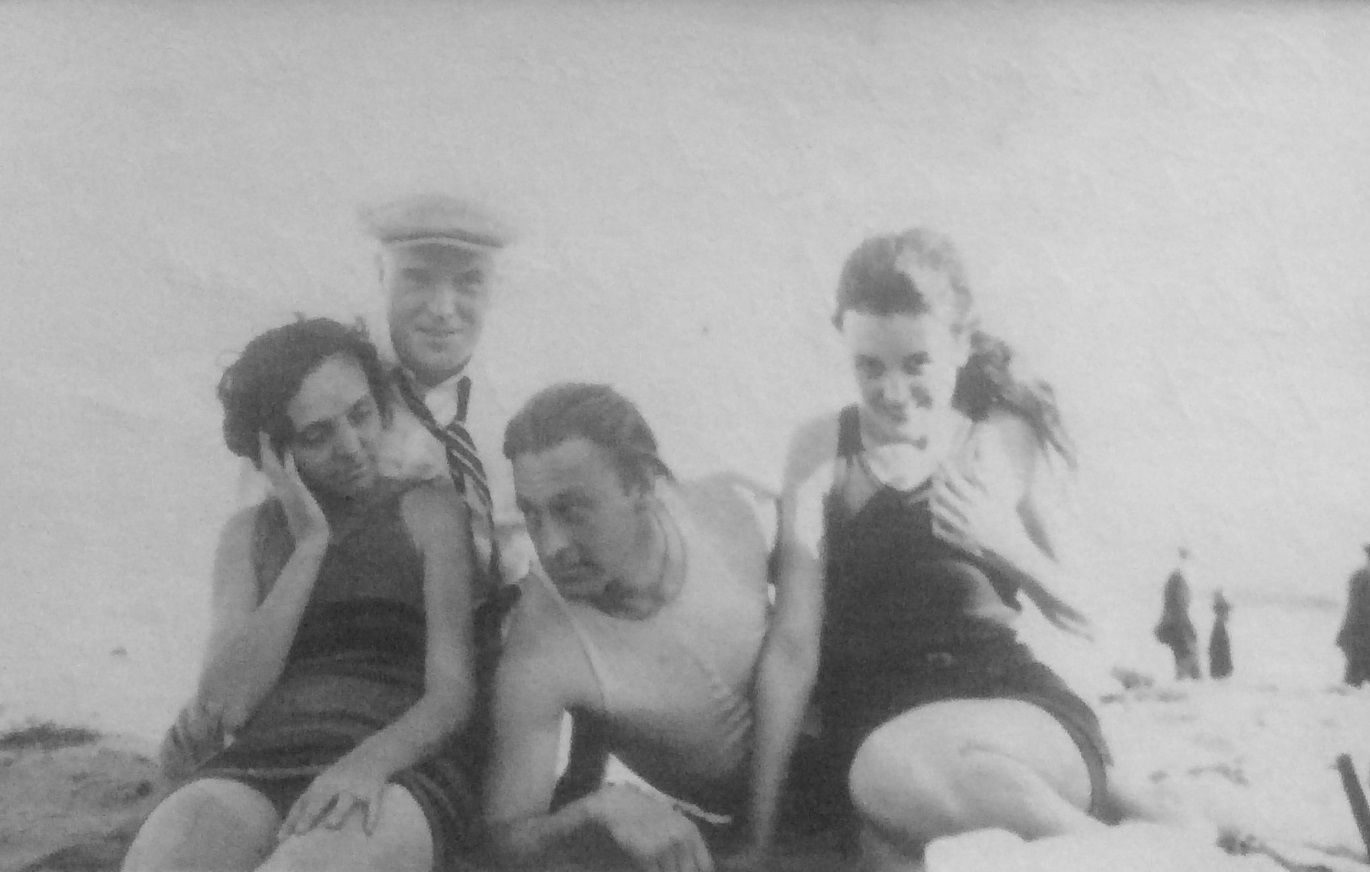
Photo Copyright Astor/Roh Estate
Barrymore with Astor and Astor’s Parents When The Two Were were lovers.
Q- Will you tell us a bit about Mary Astor and her romance with John Barrymore. She was 17 and he was FORTY
A-As is known Mr. Barrymore liked young women. He had seen a photo of Astor and asked for her to star with him in Beau Brummel a big expensive 20s silent production. He first met Astor on the set for (I think) costume tests and immediately began his seduction with “You are so beautiful you make me want to faint.”
Astor had two very controlling parents who basically saw their daughter as their meal ticket and, so, she wasn’t allowed friends or to do anything someone her age—she was 17—would normally do. At this point in her life, except on the screen, Mary Astor had never even kissed a boy. In other words she was a total innocent. So, she was much flattered by Barrymore and overwhelmed that a man of his fame and stature within the profession would be interested in her. Eventually Barrymore did go to bed with her and the affair lasted for 17 months.
As a lover Barrymore used the bedroom with Astor to educate her not just about sex but about art, music, literature and he gave of himself completely. So, it wasn’t long before Astor just wasn’t in love with the man but worshipped him. Barrymore wanted to marry her and asked her countless times but she always said no. Astor feared her parents but more importantly had been made to feel so insecure by them in the way they treated her that she didn’t have the courage to break away from them because Astor felt emotionally safe only within their dominance of her.
Eventually Barrymore told her that she was spineless and didn’t have the courage to take control of her own life and so, losing all respect for her, and realizing that she would never break with her parents, turned his back on her. While the two worked on Don Juan together he had already taken up with Dolores Costello and when Astor realized it was over she was devastated. So, devastated in fact that she finally began to take charge of her own life. Years later while the two were making “Midnight” Barrymore told her that it was a good thing that due to her parents they never married because he would have ruined her life. He was probably correct about this
Nevertheless, Barrymore remained the great romantic love of her life and, although over the years she discarded so many things she had accumulated she kept all the telegrams Barrymore had sent her while he as on tour with Hamlet and to her dying day was proud of the fact that, as she saw him, this marvellous and incredibly alive man had been in love with her enough to marry her.
In fact, when she was in the MPCH towards the end of her life she told one of her granddaughters that John Barrymore had saved her because all she had known about sex and love came from her parents and frankly they had an extremely dysfunctional marriage. It was Barrymore who had taught Mary Astor how to love and how to express it in physically, something that her parents had never done with her. Unfortunately because she had been emotionally stunted having been raised by selfish parents who only saw her in terms of their own wants, all her life Astor remained an emotionally immature woman whose inner needs far outstripped her limited emotional resources to fulfil them.
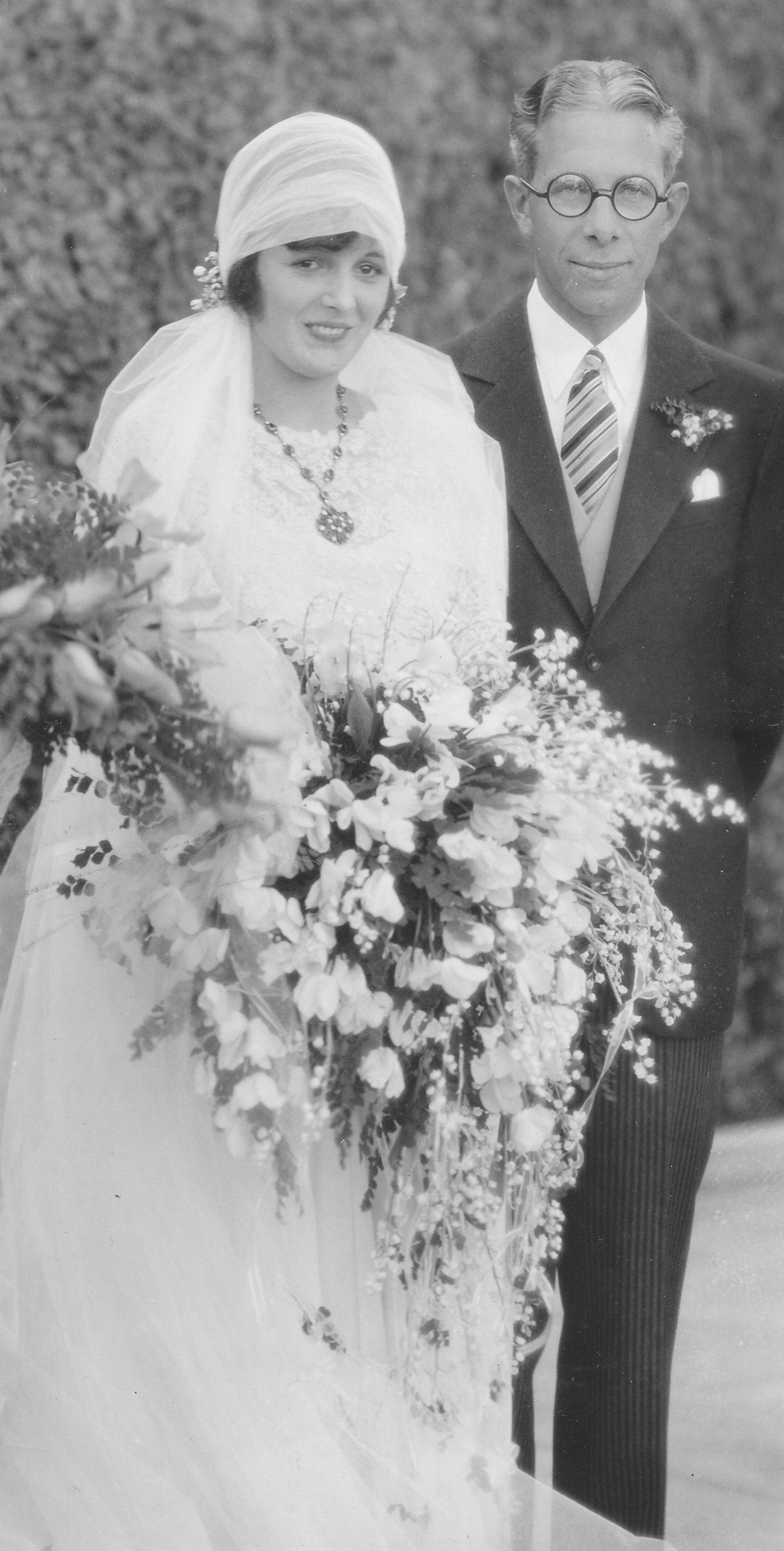
Mary Astor And Kenneth Hawks On Their Wedding Day
Q- And about her first husband Kenneth Hawks.
Having broken away from her parent’s dominance Astor finally began making friends and was part of a circle that included MGM Head OF Production Irving Thalberg, Thalberg’s wife Norma Shearer, Frederic March, his wife Florence Eldridge and several others. She also took up with a number of men just to prove that she was over Barrymore and even had a short engagement to Irving Asher who later married Laura La Plante. Eventually she met Ken Hawks, brother of director Howard Hawks, who was a producer at Fox. Astor had never met a man like Hawks before. A Yale graduate he was cultured and well lettered as well as a champion sportsman. But, unlike Barrymore, instead of treating Astor like a student, he treated her like an equal and it wasn’t long before the two fell in love.
Hawks was a straight arrow and it was agreed no sex until marriage. Instead they dated, became engaged and grew very, very close. For the first time Mary Astor was loved for herself and understood what real love was—total and unconditional acceptance. So, they were married in January 1928 in a big Hollywood wedding but unfortunately, Hawks had a very low if non-existent libido. Their wedding night consisted of a goodnight kiss. The sex that they did have was infrequent and, after having been John Barrymore’s lover, not particularly satisfying for Astor. So, thinking this would save the marriage, Astor had an affair and became pregnant. She had an abortion but Hawks having found out what Astor was doing an, feeling that he was letting his wife down, began drinking. Astor, racked with quilt and realizing that she was causing Hawks so much pain, broke off the affair. She also realized that she had to accept the sexual limitations of the marriage in order to feel the sense of protection and care that her husband was giving her and she so desperately needed. So, she learned to tailor her sexual needs to what her husband could provide and was soon both happy and satisfied.
It should also be understood that while she was married to Hawks he never accepted a dime of the money she made and at that time Astor was earning $4,000 a week. The two lived only on the money he made and her pay checks went directly to her father who was living like a millionaire in a mansion with three servants and a chauffeured limousine. As Astor didn’t want to battle with her oppressive father she just let it slide happy to be with a man who loved her for herself and not her pay check.
Then in January 1930, Hawks—who like his brother Howard—was now directing, was killed in an airplane accident while filming a scene for a movie he was helming. Astor was devastated beyond words. She felt she had lost everything. She couldn’t even go back to their house and get her things. She just left everything there and moved to an apartment. She knew that being in that house with all the memories of her life with Ken would have been unbearable.
Earlier, when sound came in, because her voice was considered too deep, Astor hadn’t worked for a year but at the time of Hawks’ death she was doing a play and the movie offers finally came. So, Astor lost herself in her work and in a series of empty affairs. She was eventually diagnosed with physical exhaustion. She had lost a great deal of weight and was in the early stages of TB. The doctor who diagnosed her was Franklyn Thorpe. Desperate for someone to take care of her, and someone she could love, Astor literally compelled Thorpe to marry her and he became her second husband in June 1931. It was with Thorpe that she had her baby in 1932 and a year after their 1935 divorce she sued for Custody of the baby which led to the famous 1936 Custody Battle which is what “The Purple Diaries” deals with.
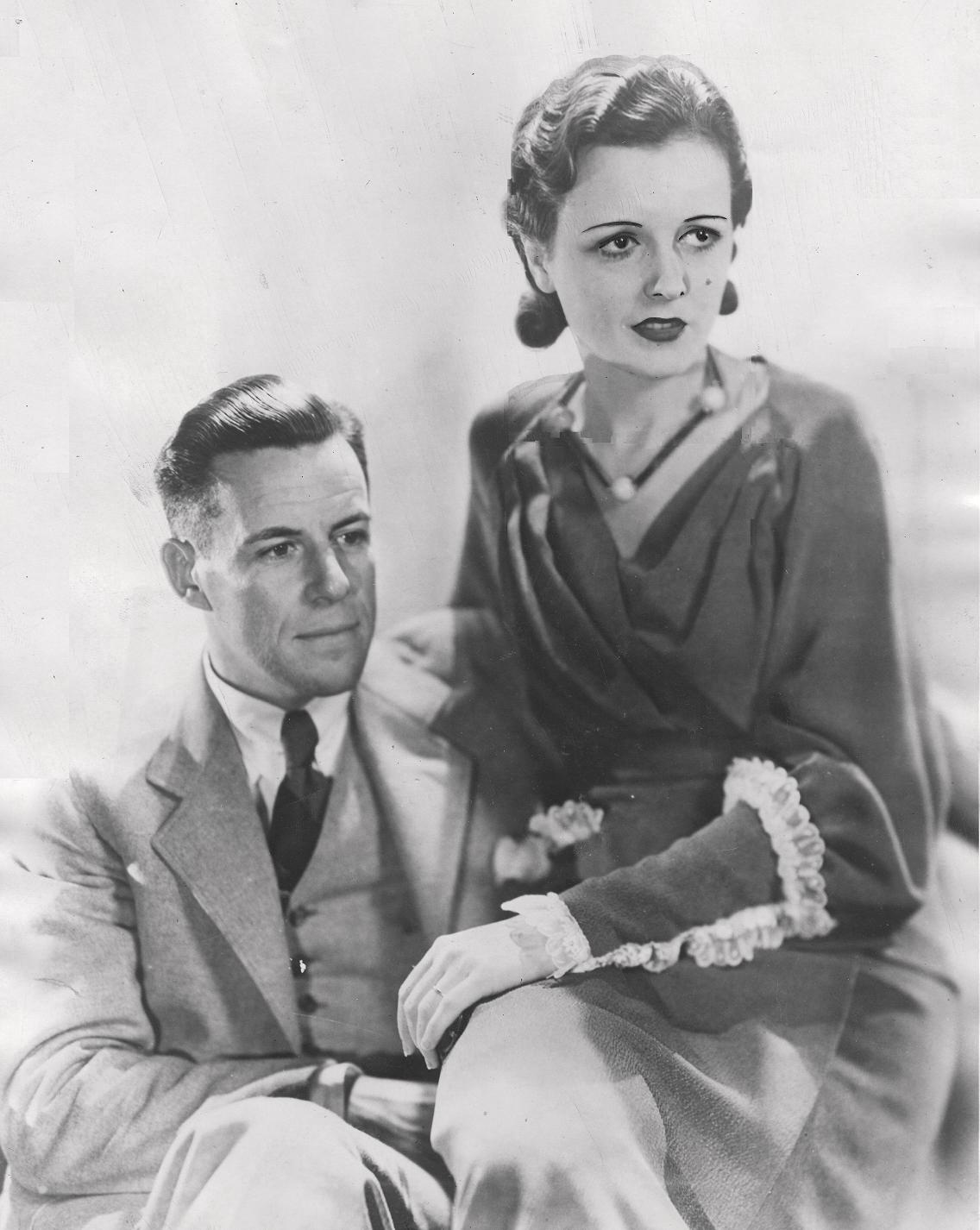
Astor And Thorpe In Their Official Wedding Photo
Q-So the trial was NOT a divorce trial but a child custody trial.
A-Exactly. The divorce occurred in April 1935 and the Custody Battle took place in July-August 1936. A lot of people are confused about this because many writers didn’t get it right because they hadn’t done their research. This is one of the principle reasons why I wrote the book.
There is a bit of a story here. Astor had wanted to divorce Thorpe as far back as early 1933, nine months after the baby was born. It is my belief that after the baby came into her life, the genuine feelings Astor felt for the child put what she really felt about Thorpe into sharp relief. She did like the man but was no longer in love with him or physically attracted. Her marriage had essentially been an act of desperation as was her plan to leave acting once Thorpe’s medical practice (she paid to start it) became lucrative enough to support them. It never did. In addition, except for Ken Hawks, with men Astor was more in love with being in love than actually able to love and for her that meant sex. When desire faded, for Astor love had faded and she felt a need to move on.
In early 1933 because Thorpe had begged her not to divorce him she told Thorpe that she would put it off hoping that things would change. It never did. But, she now felt free to take up with other men to satisfy her sexual needs. So, that May in 1933 on a trip to New York she met George Kaufman, America’s most successful playwright. What Kaufman lacked in looks he more than made up in charm. It took a week but they began an affair that lasted-off and on—for the next two and a half years. It should be noted that Kaufman had many woman at the same time and Astor was just one among many. But to Astor—with her insatiable need to love and be in love—she built it up in her mind as the love of the century. In September 1934 Astor finally told Thorpe about the affair after he told her about his affair with old flame, Lillian Miles. He also told Astor that he had given Miles an abortion. (Thorpe was a gynaecologist.) By this time the two had a de-facto open marriage.
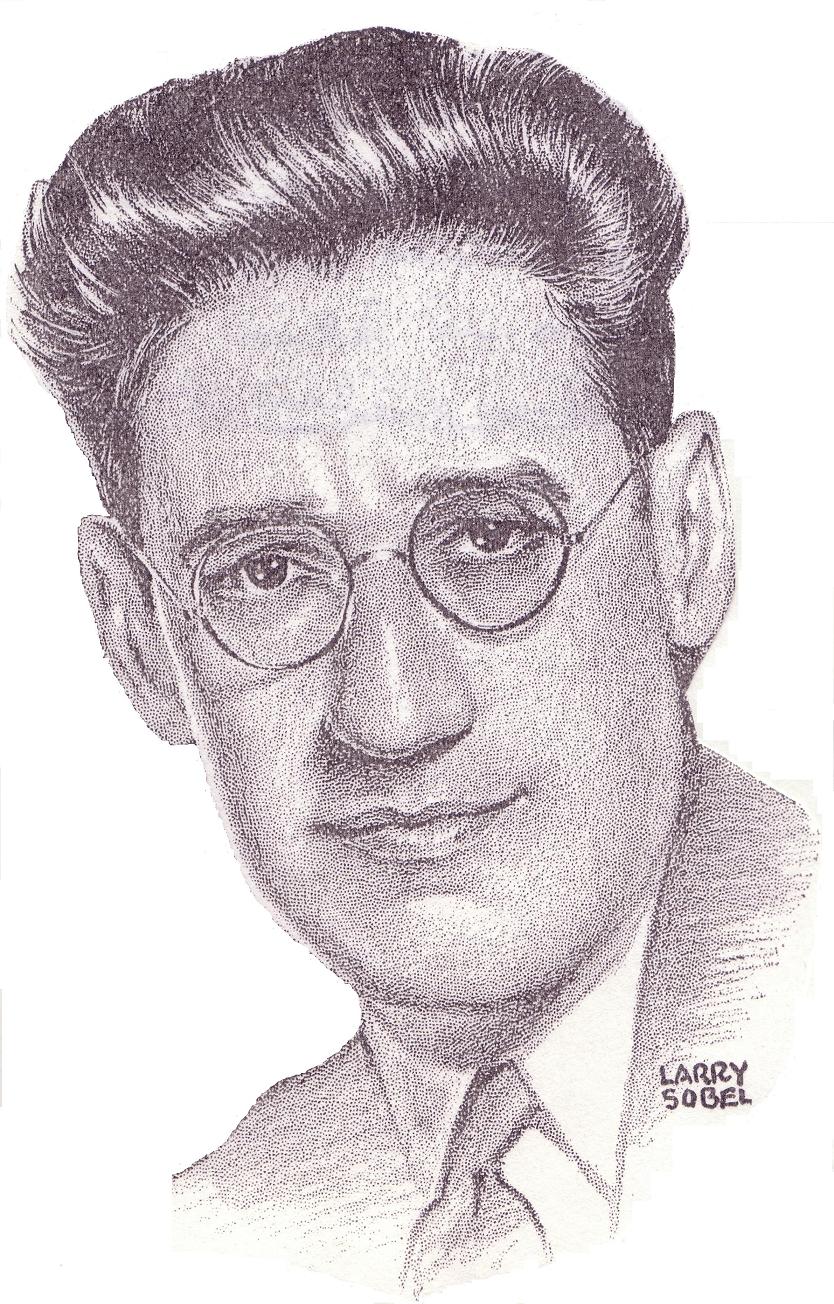
GEORGE KAUFMAN
But, what bothered Thorpe was that he was hearing talk about the affair with Kaufman and that September 1934 had asked a friend to talk to Kaufman about it. The friend refused. In early 1935 Kaufman came to Hollywood to work on A Night At The Opera for MGM at $10,000 a week making him the highest paid writer in history. Astor now took up with him openly not caring who knew and soon items began appearing in the press about the two without mentioning their names. This upset Thorpe enormously. He and his wife were now engaged in serious discussions about a divorce which to him—a man very much a product of his times—was unthinkable as it meant that he was a failure as a husband. This and the talk around town about his wife and Kaufman, made Thorpe decide to pay Kaufman a visit and basically threaten to name Kaufman as co-respondent if Thorpe and Astor divorced. As Kaufman was guarded about his private life be found this upsetting and told Astor. She blew her top and confronted Thorpe and a major fight ensued. Divorce was the main topic and he would only give it to her if he had shared custody of the baby which she was not agreeable to do. As the fight went on all night, by morning she agreed to hold off while secretly concluding that she would go through with the divorce after Kaufman left Hollywood—so that she could enjoy a trouble free time with the playwright before he returned to New York and then she would rent a house and move out with the baby.
Mary Astor had written this in volume two of her two volume diaries. A servant read it and, reading about her plans to leave with the baby, told Thorpe. Thorpe then stole the diaries and read them. In those two books Astor had written everything about her affairs and her real feelings for Thorpe who at this point in the marriage she basically felt sorry for. Learning things about his wife’s affairs dating back to the 1920s and what his wife really thought about him Thorpe was stunned, feeling that he had been played as a “Sucker” by his wife. Also in the diaries were passages about the private life of many of Mary Astor’s friends. Thorpe was so incensed that he now threatened to make the diaries public and scandalize his wife if she didn’t give him FULL custody of the baby and control of all their property and assets. He went on like this for weeks screaming and shouting day and night for hours on end and driving the woman to distraction. Finally, sick with a flu and a high temperature and barely able to get out of bed she simply couldn’t fight him anymore and felt she was licked. If made public the diaries could ruin her and ruin the careers of friends who had nothing to do with any of this. So, with Thorpe agreeing to let her have the baby for six months a year she gave him custody and everything else he wanted and moved out with the baby. The divorce was granted in April 1935
Then, over the next 15 months seeing how he was treating the baby—hitting her in fits of temper for nothing and constantly undermining Astor’s authority as a mother—she made a decision that she no longer cared about her career and if she had to she would become a buyer for a department store. Despite the diaries Mary Astor was going to make sure that her baby bay was raised properly. So, going for broke, in July 1936 she filed a petition to regain custody and the rest, as they say, became Hollywood history.
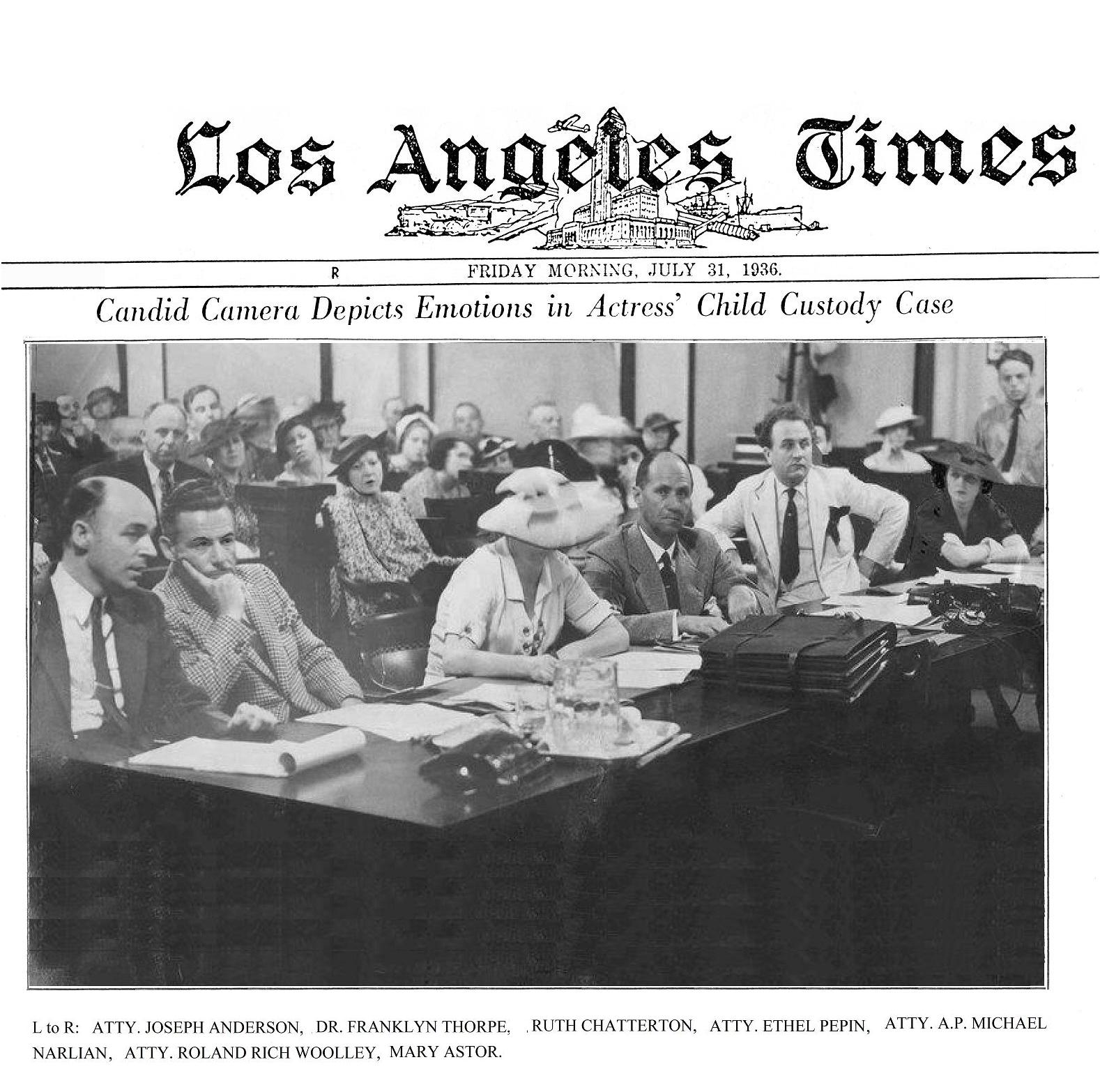
Q-Tell us more about what happened at the trial. As I remember Astor was making Dodsworth at the time – in the daytime and attending court at night. And is it true that co-star Ruth Chatterton went to court with Astor to help her get through the ordeal?
A- She was making Dodsworth and Chatterton was with Astor in court every day providing support. As I mentioned earlier, written in those two, red cornered ledger books which Astor used for her diary, were not only detailed descriptions of Mary Astor’s personal activities—including extra marital affairs—but what she knew and/or heard about the activities of others. For example, when Mary Astor married Ken Hawks in 1928 she became a member of an extended family that included Irving Thalberg—perhaps the single most powerful studio head in Hollywood. Before marrying actress Norma Shearer Thalberg was quite a womanizer running around with John Gilbert and the Hawks brothers. There was a good possibility that Mary Astor may have discussed this in the first volume of her diary written during her marriage to Hawks. If made public it would be an immense embarrassment to Thalberg, perhaps even adversely affecting his career. What might be true of Thalberg could also true of many others. This was during the highly moral 1930s when adultery—or any sex outside of marriage—was universally condemned and could and often did destroy Hollywood careers. So, at the time of the divorce Thorpe made it clear that if Astor didn’t relinquish custody of their daughter he would make the diaries public with the intention of destroying her career and the careers of anyone else whose private indiscretions were mentioned in the two ledger books.
Unfortunately, as I mentioned earlier during the 15 months following the divorce when Thorpe had full custody of the baby—and prior to the custody battle—Thorpe continually countermanded the set routines that Mary Astor was implementing with the baby by threatening to take the little girl away from her mother. Mary Astor soon realized that this conflict between herself and her former husband worked against the consistency that she was trying to implement with Marylyn and, eventually, would cause the baby emotional harm. There was also the fact that Thorpe was extremely harsh in his discipline of the baby and whenever Astor tried to interfere he would always threaten to take the baby away. As Astor saw it, all of this adversely impacted on her effectiveness as a mother because Thorpe–in sheer spite—was putting his needs ahead of the baby’s. Ultimately, this was the reason why she went to court. Having been raised by parents who had also put their needs first, as an adult, Mary Astor was a woman with substantial emotional problems and didn’t want the same thing happening to her little girl.
So, returning to court 15 months after the divorce Astor was now ready to put everything, including her career, on the line for the sake of her child. Knowing that during this court action the diaries might be put into evidence and go public—which Thorpe tried very hard to do—Mary Astor understood that she would become a pariah in Hollywood both personally and professionally. Consequently, the court battle and the dread over the diary’s contents going public put the fear of God into Hollywood because of the damage which diary revelations might have on the careers and box office draw of anyone even associated with it.
Fortunately Astor had a brilliant attorney who fought in the courtroom while Thorpe’s attorney did much of his fighting in the press, continually threatening to introduce the two diaries. Unfortunately for Thorpe and his threats, Astor’s attorney managed to keep the two ledger book diary out of evidence on a technicality. Earlier, Thorpe’s lawyer had pulled one of the volumes apart to be photo-stated and two pages were missing (concerning Thorpe giving girlfriend Lillian Miles an abortion which could have led to criminal charges.) The technicality was that a mutilated and/or incomplete document could not be submitted as evidence.
So, with the diary out as evidence Thorpe lost his main leverage. In a last ditch effort to regain it, he released to the press the section of the diary dealing with Astor’s affair with Kaufman. It got him nowhere as the judge, disgusted by all the publicity and threats, put a halt to the proceedings and told Thorpe and Astor to work out a compromise or he would do it for them. So, over a two day period a compromise was reached whereby Mary Astor had the baby for 9 months and Thorpe 3 months during the summer. Regarding the diaries, once Thorpe’s attorney turned them over to the Judge they were never again in the possession of either Mary Astor or Franklyn Thorpe. Sealed by court order and put in a bank vault, they remained there until Marylyn turned 21 and a custody issue was moot. Mary Astor with Thorpe’s approval asked for it to be burned and it was incinerated in the presence of a judge.
In the end Mary Astor had won. When the film on which she worked during the court battle, “Dodsworth,” was previewed, the moment that her name appeared in the opening credits the audience cheered. In short, the public had seen the custody battle as a mother fighting for her child and all the revelations that came out due to the diary excerpts—real and false—were neutralized because it had also come out in court that Thorpe was a unrepentant lothario type who had slept around even when he was married to Mary Astor. Thus, his indiscretions counterbalanced Astor’s and the result was that Mary Astor was not only able to raise her baby but her movie career was now bigger than ever.
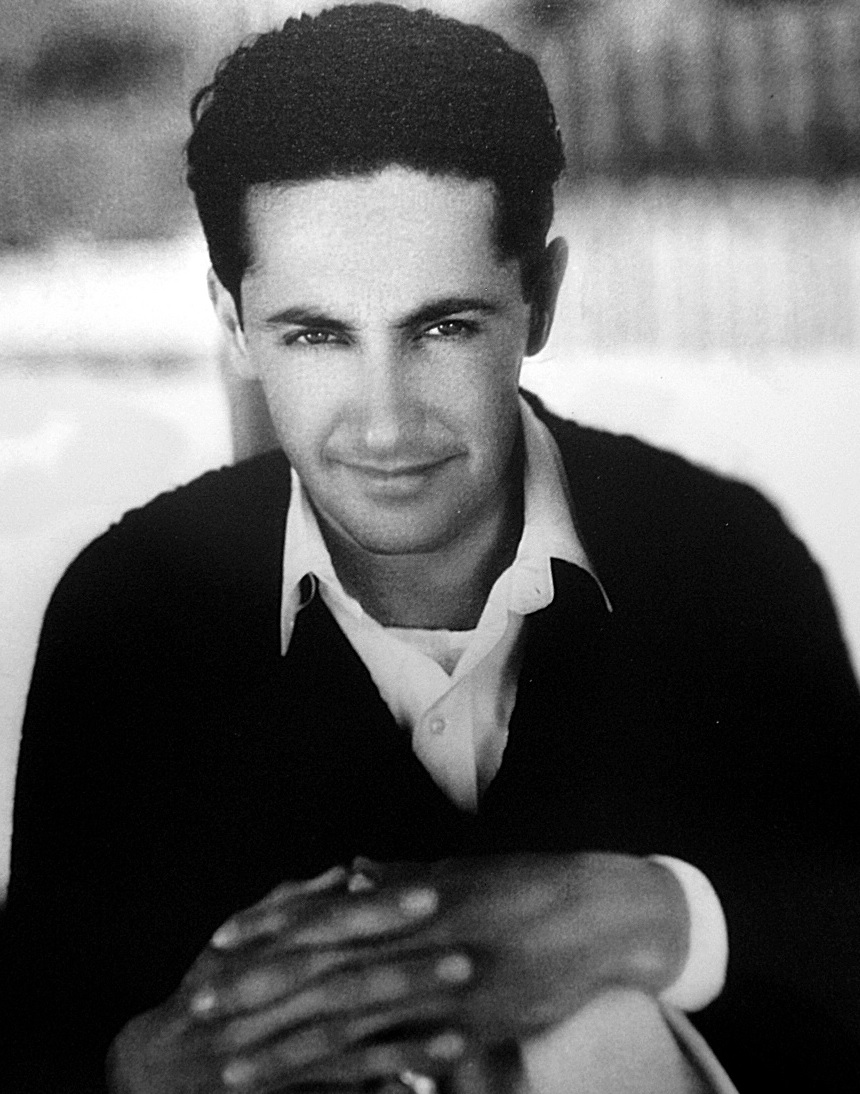
MGM Producer and The Studio Head’s Spokesman At The Meeting
Q- Will you tell that unbelievable story about the studio heads’ meeting and trying to stop Astor from continuing with her trial?
A-This an absolutely great story. On her last day working on “Dodsworth”…It was Saturday, August 8th, 1936—at the end of shooting Astor was surprised to be called to Sam Goldwyn’s office. She was even more surprised when she got there and saw standing in that room the heads of every studio and their lawyers. They had all gathered to convince Mary Astor to settle the case. It seems that they had been given a copy of the forged diary with sexual performance scorecards and steamy passages and believing this to be the real diary, and, if it went public it would bring down the wrath of the public and Legion of decency as well as the possibility of government intervention and censorship. It should be understood that in that room were the most powerful men in the industry; men who could make or break a career at the drop of a hat.
So Irving Thalberg—this was about a month before his untimely death—spoke for the group and tried to persuade Astor to settle arguing that if the Diary was made public—thinking the pornographic forged one was the real diary—it would destroy the industry. Listening to Thalberg Astor thought the whole thing ridiculous; that her diary would bring down the motion picture industry. When she heard that it was pornographic she protested that there was nothing pornographic in what she wrote but wasn’t believed.
So, putting her daughter first and her career and these men’s wishes last, Astor stood up to all of them and told the gathering that she would continue with the trial until she won her daughter back. And with that, left the room. Now, that took guts but Astor didn’t care because she had already pushed all her chips into the pot and was going for broke.
As an aside, Goldwyn was asked if he would threaten Astor with enforcement of the morality clause in her loan out contract with Columbia. Goldwyn’s reply, made famous in Astor’s autobiography was “A woman fighting for her child…this is good.” And that was the end of the mogul meeting.
Q-After the scandal, did Mary ever run into Kaufman again socially?
A-Their affair had ended in the fall of 1935 so Kaufman made it a point to avoid Astor as she did him. Astor had a child to raise and didn’t want anything about that hearing to pop up again. To the best of my knowledge they never even spoke to each other. In fact, I read somewhere if Astor’s name was mentioned in Kaufman’s presence he would glare disapprovingly at the person who spoke. But that could be just a rumor.
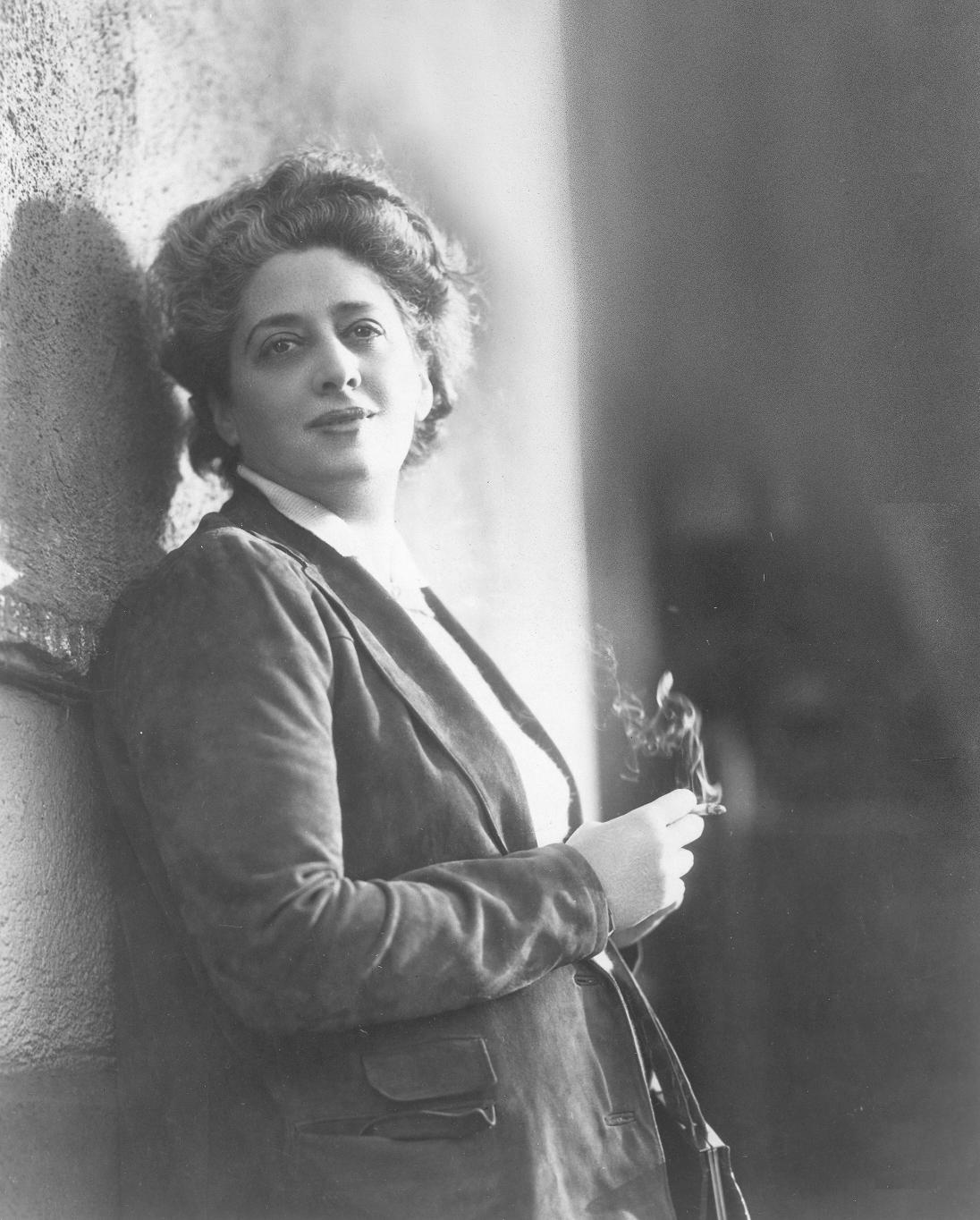
Beatrice Kaufman
Q- What was the reaction of Bea Kaufman, when her husband’s sexual exploits were suddenly all over the front pages?
A-Publically she said it was just flirtation and that she and Kaufman were happily married. Privately, Beatrice was embarrassed as now it had gone public that she was not really a “wife” to her husband and this pointed up to her inadequacies. This is why neither she nor Kaufman ever again spoke about it publically.
Q-Years ago, when they did a revival of “You Can’t Take It With You” on Broadway, I found myself sitting next to Kaufman’s last wife Leueen MacGrath. She was elderly, tiny, gracious and lovely.
A-She was no Beatrice Kaufman who was a powerhouse and basically ran Kaufman’s career and made George Kaufman George Kaufman. When Leueen thought the time was right she divorced him. It seems that Kaufman preferred friends as wives and regarding sex as something to be done outside of marriage. In no way could he be called a conventional man
Q-Were you always a Mary Astor fan.
A-I always liked her but it was not until I began compiling the material for a conceptual piece that I really became interested. Here I quote again from the book’s website. How The Purple Diaries came to be written is an interesting story in itself. A number of years ago I wanted to put together a massive conceptual installation which would consist of a series of paper collage works dealing with the American film Industry from the 20s through the 90s. One collage per decade it would alternate the complete newspaper coverage of a film release verses a Hollywood scandal. For the 30s Mary Astor. I never got around to completing the entire 8 part work as no gallery really had the space and, frankly, I had moved on. Nevertheless, the Astor material intrigued me It was about a woman who, for the sake of her little baby, took on the media and the Hollywood establishment to do what she believed was right. As I read and reread this material as well as Astor’s two auto-biographies, I learned about the woman’s emotionally deprived childhood—and how tremendously difficult it had been for her to go to court and fight for her baby. This struck a chord with me
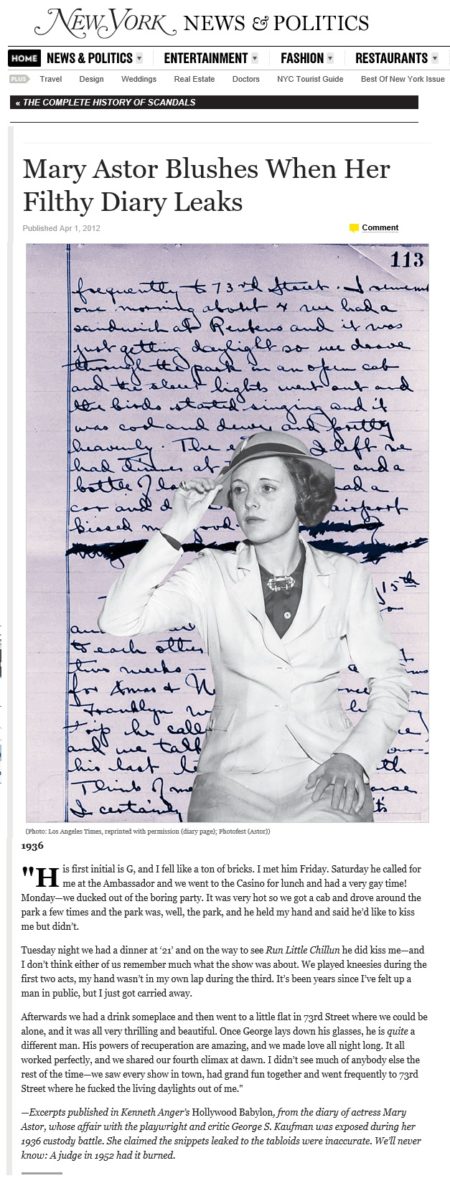
2012 New York Magazine Piece On Astor Custody Battle
I soon discovered that every book and even magazine article written years after the fact which contained an account of the scandal—either briefly or at length—had never gotten the story right but, more often than not, printed rumor as fact. The idea of utilizing the Astor material to write something about the custody battle was sparked when I read the Mary Astor chapter in Kenneth Anger’s hugely successful book, Hollywood Babylon. It was Anger’s intention to scandalize and he succeeded quite well at this. Thus, the piece on Astor was filled with so many falsehoods, often substituting the salacious for the truth that I felt the record needed to be set straight. Unfortunately this idea languished for a number of years until I read a short piece on the trial in the April 9, 2012 issue of New York Magazine for which Anger’s book was the principal source. In short, Hollywood Babylon and its many falsehoods had, and would continue to be, source material for any writer wanting to discuss the Mary Astor Franklyn Thorpe Custody Trial. This proved to be just the motivation which I needed to write something that would finally ‘set the record straight’ which I believe that I have done.
At this point in the process, it was not my intention to write a book. I thought I was merely writing a long form magazine piece of no more than 20,000 words in which I planned to tell the story in two parts. The first would deal with the events leading up to the custody battle and the second with the custody battle itself. The writing of the first part was pretty straight forward and took me about a month. I used approximately fifteen sources—mostly books and a handful of newspaper and magazine articles. After reading and thoroughly absorbing this material I quickly determined how I wanted to tell this part of the story. So, after sitting at my computer, I spread these books and articles on the floor beside me and began to write. When I needed a quote or to clarify some background information, I would stop writing, pick up a book or article, find what I needed and then continue at the computer. Eventually, I produced what would become the first six chapters of The Purple Diaries.
The second part—the trial section—unlike the first for which I used a limited number of sources, was extremely complex. It had a large number of players acting simultaneously. It also concerned some relatively complex courtroom machinations. This all had to be culled, for the most part, from nearly 1000 contemporary newspaper articles. There was no way that I could work with this massive amount of material spread out on the floor beside me. Frankly, it was simply too overwhelming. I needed a better solution.
So what I eventually did was sit down and, over a period of about month—article by article—cataloged what each character did and said on a given day as well as what was happening in court. I also noted what the various newspapers were reporting. That done, I then went through it, eliminating repetition so that, when it was completed, I could instantly determine what this or that character was doing or saying on a certain day. It certainly wasn’t easy to get this done in a month as it was pure drudge work but the result was a research “bible” that I could use to write the story in a quick and coherent manner. Nevertheless, this “bible” was merely carefully cataloged notes and in no way gave any indication, or even a hint, of the eventual structure of the book.
After contacting Mary Astor’s daughter, Marylyn at the beginning of February 2014, I resumed writing. But this was a very different kind of writing than I had done for the first part of the envisioned magazine piece. There, I was able to impose my own ‘take’ so to speak—my own overriding interpretation of these events by what I chose and not chose to write about. For the second part I soon learned that the events themselves would determine the story and I would merely act as a Greek chorus clarifying what was happening for the reader. The first step would be to create a bare bones outline to guide me when I actually wrote the book proper. This outline—or superstructure as I liked to call it—was crucial as it would serve as the backbone of the book. So, as the outline and, later, the book grew out of the material, my sensitivity to this fact—and lack of resistance in allowing the material to take on a life of its own—became the key to writing the rest of the book.
Q-As for some of your resources, what did you find helped you in your research?
A-Always go for primary and rely on books or articles if written by the sources. And even then check every fact and every date. Never accept material written from memory as fact unless it is thoroughly researched. And if it is not primary, check bibliographies for primary and read them for yourself.

Lincoln Center Library For The Preforming Arts-A Division Of The New York Public Library

Museum OF Modern Art
Q-Did you find certain archives more helpful than others?
A-For film related writing the Research Division of the Lincoln Center Library and the research departments of the Museum Of Modern Arts are tops. Also, through the use of interlibrary loan you can have access to every journal, newspaper, publication and book in the world. Make sure you are working with a library that has an interlibrary loan service. Working through a good college library can’t be topped.
As of late I have found that a great deal of primary material is on the web including all sorts of Hollywood publications that have been indexed which makes searching much less difficult. During the later stages of writing this book I did much of my research and fact checking through the web. This is a resource that is going to get even better.
Q-What websites would you recommend to aspiring biographers?
A-Every single one that refers to the topic you are writing. Writing a history you have to be nothing less than thorough. Anything else is unacceptable. I was fortunate in that I was writing about a specific event and not a biography which would have required infinitely more work. Here again I am quoting from the Purple Dairies website in which I detail the writing of the book.
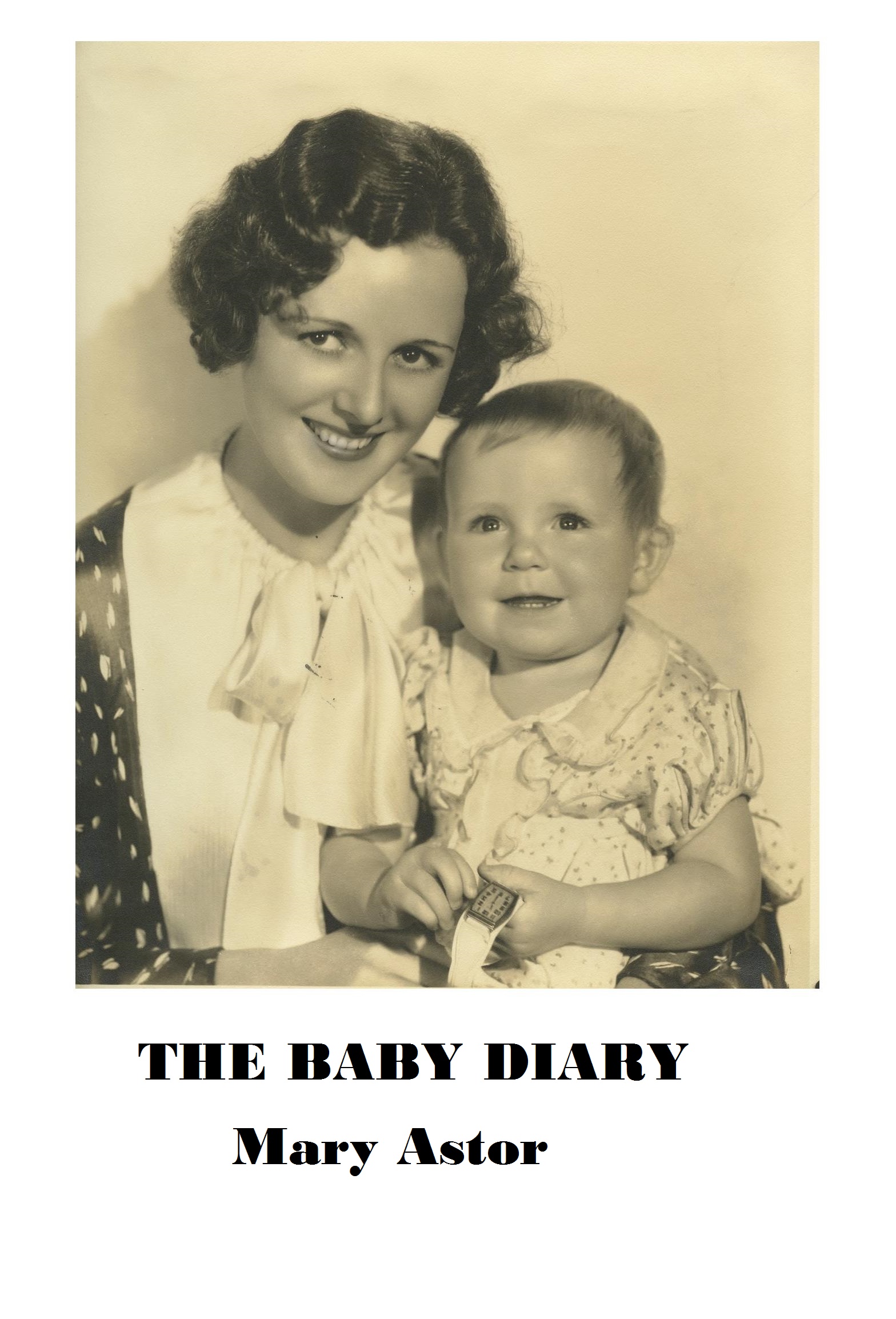
Q-What was the thing that surprised you the most from your research for the book?
A-That’s a very good question that set me to thinking. There are a couple of things that surprised me. First and foremost was how many writers got the story wrong because they simply weren’t willing to spend the time necessary to do a little primary research. Then, how one false story is used as source material for another and then that for another until truth is lost. Surprisingly, this is done by some very respected publications. Second, how difficult it is to write a book like this and keep your facts straight rather than falsely construe things. This forced me to be hard on myself and almost fanatical about putting down what I knew was fact sure it had happened when facts proved it to be a certainty. One reviewer called “The Purple Diaries” a fact driven book and this is absolutely correct.
Finally, really digging into Astor’s life, I understood how difficult this was for Mary Astor and realized that she did it not for herself but out of absolute love for her daughter. Astor wrote what I titled “The Baby Diary.” In it she chronicled the development of her baby from birth until Marylyn over to her father in October 1935 for six months as part of their verbal agreement at the time of the divorce. I’ve tried to get it excerpted in various magazines but no one was interested. Nevertheless, I have never read a more beautiful statement of a mother’s love for a child as Astor watched this little bundle turn into a human being with a personality of its own as well as its own individuality. Read this little volume and you will see for yourself that this mother love for her child was inestimable.
Q- It’s amazing how you chronicled all the different aspects of the court case; the characters, the timeline and the events.
A-Well it did became a project that overwhelmed me. My editor told my agent that in all his years he never worked with a writer who was more passionate about a project then me. Also, I believed that Mary Astor, someone whom I respect enormously, deserved the best I could do as she never did anything less than the best in whatever she did. This includes both the Court battle and raising her daughter. And then of course there was her daughter, Marylyn, who helped me so much and the book wouldn’t have been possible without her generosity. She also deserved the best I could do. She is a very great lady and evidence of the good job Astor did raising her daughter. Astor may not have been the perfect mother but as Marylyn told me, she was the only mother Marylyn had and she was also the best mother Marylyn had.

Q-What would you say to people who only know about Mary’s diary from “Hollywood Babylon”.
A-Anger wrote a book to debunk what he believed was the public’s misconception of Golden Age Hollywood as this sort of dreamland. In other words confusing reality with the dream factory illusion the studios of the period turned out. Anger had been a child actor in Hollywood during the 1930s and came away seeing the town more a “Day of The Locust” than a “A Star Is Born.” So he wrote the book accordingly and chose to illustrate it with extremely unflattering press photographs where it suited him. There is nothing wrong with that. The trouble that I have with the book, and this is pretty much based on his chapter on the Custody Case, is that not only did he get the basics of the story wrong but made things up to make the story seem far more salacious than it really was. In fact, as I already mentioned it is his invalid presentation of Mary Astor’s fight for her child that became one of the principal reasons why I wrote the book.
Q-Do you think a transcript exists for the trial? Your book is so thorough that I was under the impression that you had gotten a transcript.
A-No, I don’t. As far as I could find there is no official transcript. Since newspapers and wire services had stenographers in the courtroom the tabloids printed up various portions of the testimony verbatim. Therefore, utilizing trial coverage from all the L.A. and N.Y Newspapers, as well as the wire services, I was able to painstakingly reconstruct major portions of the trail transcript. It was one of the most difficult things I did writing this book.
Q-Is there any newsreel footage of the trial? I know there are many photos of the trial taken by the swarm of newspaper photographers. I cannot imagine the noise and crowd and claustrophobia in that courtroom.
A-You know, it’s interesting that you should ask that question. I am doing the research for a filmmaker who is working on a documentary about the Custody Battle. I’m doing the research because of my knowledge of the subject, I am pretty well suited to do it. And yes, you are right, there are tons of photos—and I have located most of the ones that are still around—but I couldn’t find a single archival newsreel house that had any footage of the trial. I also inspected each of the photos—taken in the courtroom as well as in the courthouse corridors—and didn’t see any newsreel cameramen which I thought was very interesting. I didn’t look into it more than that.
Since the L.A. courts in those day allowed photographers in the courtroom there are plenty of photos of witnesses on the stand and of Astor, Thorpe, Astor’s Mother and Thorpe’s father and mother as well as Lillian Miles, Thorpe’s girlfriend and others in and around the courtroom. Because most of the major newsreels emanated from Hollywood studios it is my presumption, and this is merely a guess, that these companies purposely didn’t cover it. Truthfully, the last thing the studios wanted was for this scandal, which could be extremely damaging to Hollywood, to become an even bigger story than it already was by newsreel footage playing in the very movie houses the studios owned. But again, that’s just me guessing about something that I really know nothing about.
Q-I can’t wait to hear more about the documentary.
It’s coming along nicely. The script is almost finished and a plethora of photographs and other visual elements have already been gathered. In addition interviews are being conducted with Marylyn Roh, Mary Astor’s daughter as well as William Wyler’s son and film historian Kevin Thomas, already filmed. She’s also planning to film Robert Osborne and feminist film critic Molly Haskell. I have great faith in the filmmaker who has forgotten more about films than I will ever know. She is not only a big fan of Mary Astor but is even more enthusiastic about the project than I am which is saying a lot.
You might find this amusing but, because I’m such a busy body, even though I live in New York the filmmaker has politely asked me to stay away from the filming as she and the person she interviews need to concentrate. I’m amused about this because the two of us are so in sync that we understand each other completely. I would like to meet Paul Osborne as I have a lot respect for the man but as I am, as they used say, very intense I might be too much for him. My wife tells me this all the time and when we are with people she will say 10 which means most intense and I should calm down. Or she will say 2 which means I’m all right. I did meet Molly Haskell a while back and found her to be absolutely delightful. If you are interested in movies she is the person to sit down and have a conversation with. Wonderful, wonderful person with a kind heart. I adored my time with her.
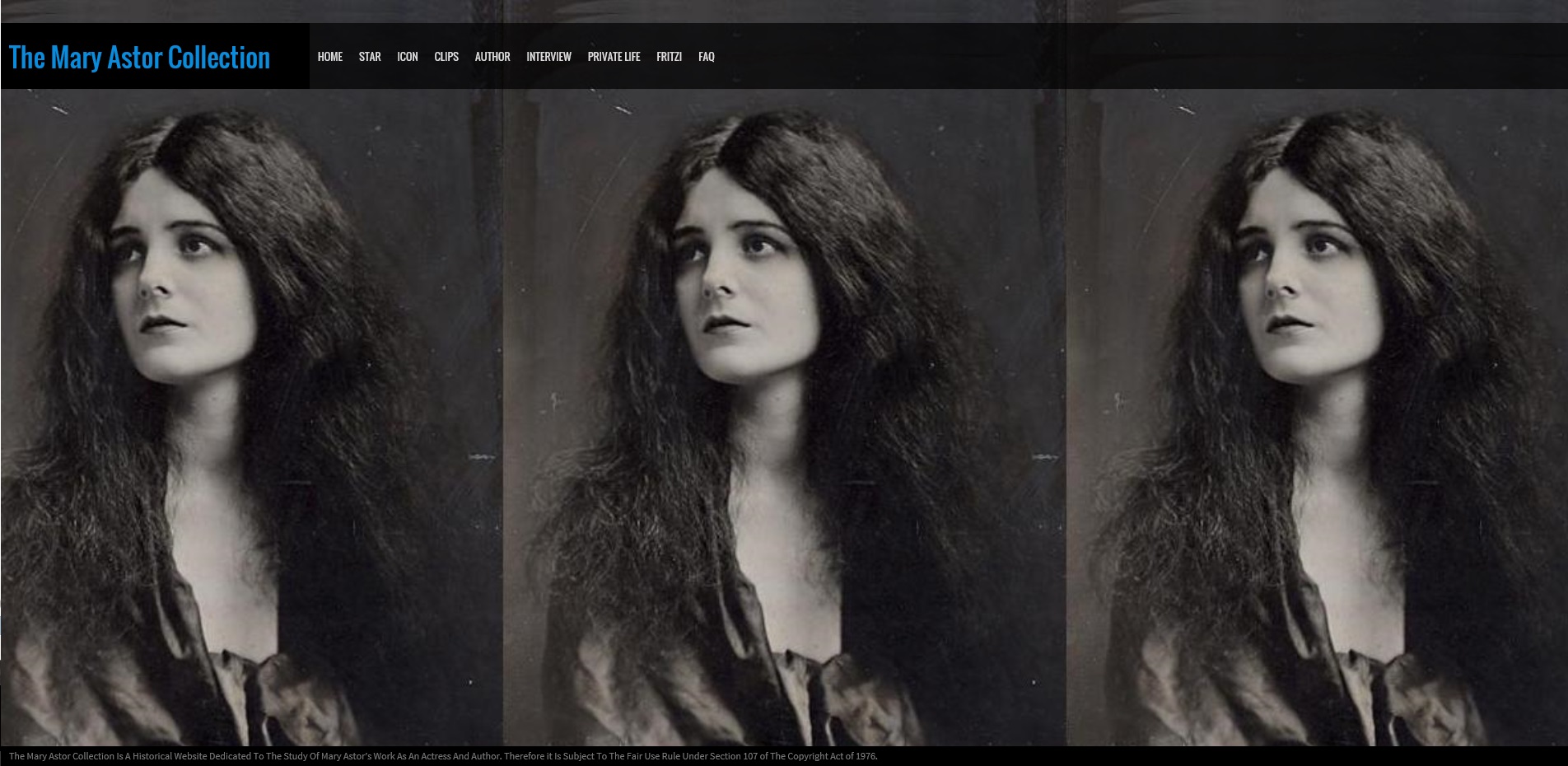
Q-Your Mary Astor Collection website is beautiful, a lovely tribute to MA.
A- I had done so much research and collected so many photographs and documents that I had to do something with it all and that’s how the idea for the website came about. Also Marylyn, and other members of Mary Astor’s family were generous enough to let me use a great deal of family material.
Q-After all your research and emotional investment in Astor, did you wish you had the opportunity to interview her?
A-You know that is the most interesting question I have been asked since the book came out. Astor really didn’t like talking about her films. She was a woman, even in her last years who lived in the present. In “A Life on Film” she pretty much said everything that she had to say about her movies. So, I think if I had interviewed her in 1984 or 5 it wouldn’t have gone very well because she would have been disinterested. I think once we turned to books—especially hers—and ideas she would have opened up more. She didn’t like chatter but much preferred thoughtful analytical conversation which is why many of her Hollywood friends in the 30s and 40s were writers and intellectuals and of course the reason why she got along with Kaufman so well. In fact Moss Hart back in the early 30s called her the smartest gal in California—referring to Hollywood. Frankly, she was a tough lady who didn’t suffer fools gladly. Therefore, I think I would have been very intimidated by her.
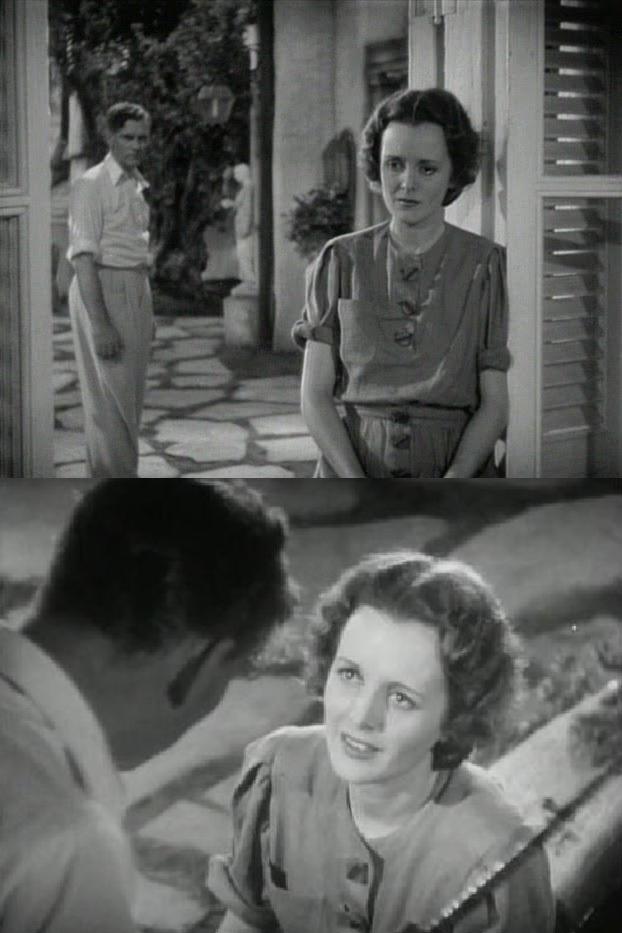
Q-I have always been deeply touched by Mary Astor’s performance in “Dodsworth.” Can you share a little about how that performance was affected by the scandal?
Mary Astor’s favourite film was “Dodsworth” and if you see the movie you will understand why. It helped her to keep her sanity during the Custody Hearing because it was being made at the same time. She could concentrate on her role and get her mind off of what was happening in court. Remember during most of the Custody Battle she was living in on the U.A. lot in her dressing room bungalow. I think by getting into the role as much as she did it kept her mind off one of the most difficult episodes of her life. This allowed her to focus when she wasn’t in court. She did much the same thing when she was preparing for “The Great Lie”—working on her piano hand movements while living at the studio. I think “Dodsworth” provided the concentration that she really needed to get through. In fact the character that she played in the film became the model for how she conducted herself in court—cool and dispassionate which was the complete opposite of how she really felt
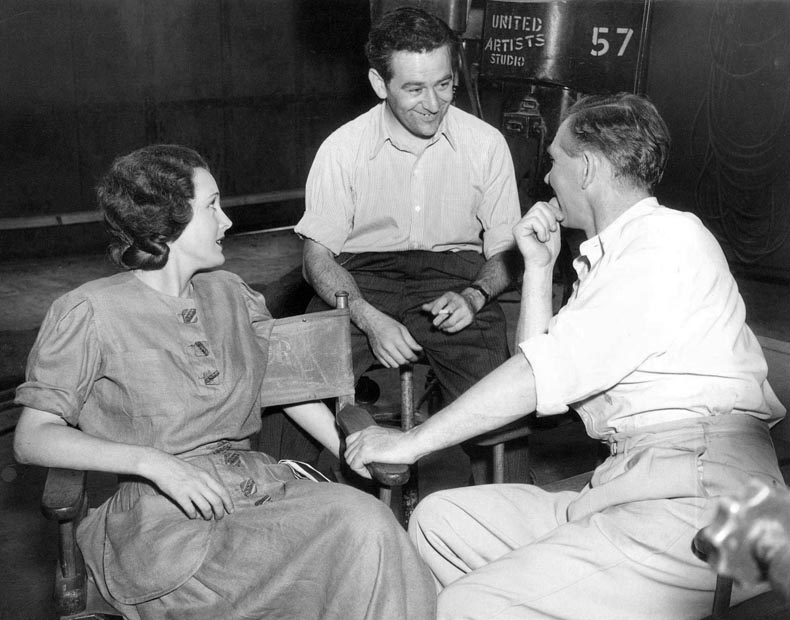
Mary Astor, Walter Huston And Director William Wyler
Q-Did she and Walter Huston have a congenial relationship?
A-She respected Huston obviously because he was the total pro. The man’s acting was always right on target. As he got older it became less and less affected and more natural. The two of them were great on screen and they got along. In fact Huston treated her to a champagne farewell on her last day of shooting. So, that has to say something about their relationship.
Q-It’s nice to know that she got along well with Walter Huston. The empathy of the cast and crew must have given Mary strength to continue her dedication to the struggle for custody.
A-That is quite true—especially with Ruth Chatterton. Despite the possibility of being harmed by the scandal Chatterton was with Astor in that courtroom all but two days of the Hearing. (she had to work those two days) When Chatterton came to court from the set during her lunch break one of those two days she told Astor in front of the press that everyone on the set wished her luck. This was not the rule but pretty much the exception because many of Astor’s friends, fearing for their careers, avoided Astor and one actress even flew with her husband to London in case she might have to testify. Outside of Chatterton and a few others Mary Astor was pretty much alone during this time and it took great strength, determination and commitment to follow through.
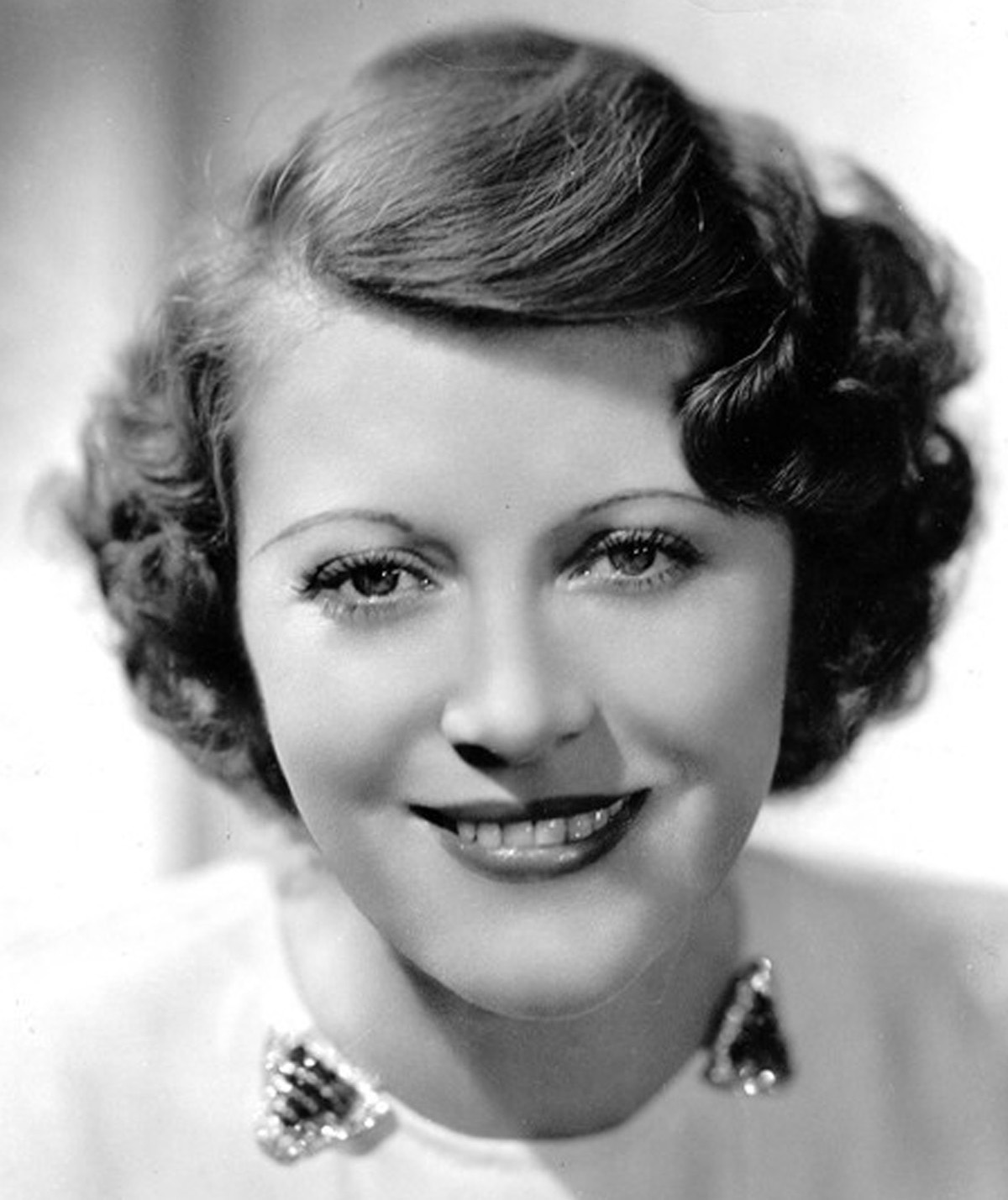
Curtesy Of Scott O’Brien
Ruth Chatterton’s Favorite Photo Of Herself
Q- It’s nice to know that Ruth Chatterton spent all but two days of the trial supporting Mary.
Chatterton was a remarkable, one of a kind woman and I am indebted to Scott O’Brien’s wonderful biography of her. Chatterton comes alive on the pages of that book. Ruth was a woman who demanded control of her life and lived life entirely on her terms. She was a feminist before the term was even coined. She was also a rabid individualist who cared little what others thought of her. Among her many accomplishments, she became one America’s top woman flyers was a trial reporter writing for a L.A. newspaper and produced many of her own plays when she worked on the stage. Ruth never saw herself as just a woman. She saw herself as a person first and equal to any man…and frankly, better than most. She was an independent thinker who when she thought she was right wasn’t the least bit hesitant in telling you. After ”Dodsworth,” in which she gave her greatest screen performance, she realized it would soon be downhill for her in the movies. So she returned to the theatre and never looked back. She eventually became a bestselling author writing about controversial subjects that she believed in and even wrote book reviews of the New York Times. Chatterton proved a very good friend to Astor and was, according to Astor a great help during the trial. Astor’s attorney believed Chatterton could have made a first rate trial attorney. A truly remarkable woman who I can’t do justice to in the limited space I have here. If you want to learn about her you should read Scott’s bio.
Q-It’s so interesting that Ruth Chatterton was also Bette Davis’ idol, which seems to show that Astor, Davis and Chatterton were similar in their interests and priorities.
A-I think that was because Ruth was a very strong person who very much controlled her career and Davis admired that. In time, when she was at Warner Bothers Davis became much the same way. In any case they were both individualists and one of a kind personalities. Astor worked with and admired both women.
Q-Do you believe that Astor’s acting changed after the scandal described in your book? Her acting improved radically after the Court Battle. She had been working at if for quite a long time and by 1936 had really learned her craft. But it was only after she began working with a director like Wyler on “Dodsworth” that she was able to display all that she had learned. By the 40s she had become a superb technician working in comedy as well as Drama. What Astor didn’t get in the early days but got working with Wyler and John Huston on “Maltese Falcon” were rehearsals. She was so good in Meet Me In St. Louis because Minnelli shot so many takes that she could rehearse on camera as she did with Wyler on “Dodsworth.” I think that working with Wyler—who was a demanding director—she gave “Dodsworth” everything she had because she was in the hands someone who demanded that she do her best and gave her the time to accomplish it. And, also, from the beginning of her career Astor was always what she liked to call a director’s pet. She believed it her job was to give a director exactly what they wanted. Thus, she was y able to both understand and develop her character in “Dodswoth” as a as a multifaceted human being which she was never able to do before. You can see this in her performance.
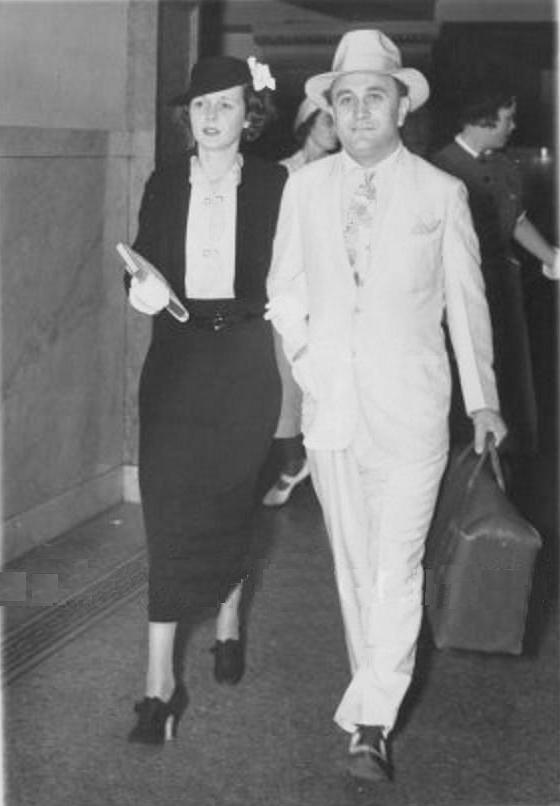
Astor In Courthouse With Her Attorney Roland RIch Wooley
Q-Astor undoubtedly had many of her nerves tested during the production of this film because of the scandal. What do you think was her greatest strength at this time?
A-I think at that time it was her determination. As I’ve written, in The Purple Diaries she wasn’t bluffing. She may not have wanted the Diaries it to come into evidence but if they did they did. Her concern wasn’t her reputation it was whether she would be able regain custody of her child. She really was going for broke and had, essentially pushed all her chips into the pot. Now, that is strength and my admiration for that is one of the reason why I wrote the book.
A-“Dodsworth” was one of the first times, if not the first time that a man is seen to leave his marriage and not suffer egregious consequences under the Production Code. Do you have any comments on why that was allowed? Was it because of the novel by Sinclair Lewis?
A-It’s a very good questions and quite revealing about how the Hollywood censorship system worked. In a code approved film someone could have all the affairs they wanted as long as in the end they were punished for it. In “Dodworth,” the extent of the relationship between Astor and Huston is never overtly stated. The film dealt with it in a very subtle manner so that you could construe that the two had a chaste relationship. But the Chatterton character, while married to Sam “Dodsworth”, overtly and without any doubt has an affair first with the Paul Lukas character and then later with an improvised young German nobleman. In fact, she is going to divorce Sam to marry this younger man until his mother tells her that she is old and what it will be like for an “old” woman to be married to a younger man. So Chatterton calls off the wedding and asks Sam to come back, She is the one who committed the infidelity so at the end, as the two wait on the ship and she presumes Sam has taken her back, according or Joseph Breen and the Hays office she has suffer. So Huston leaves her to return Astor leaving a shattered Chatterton devastated. And that is how they got around the censorship issue.
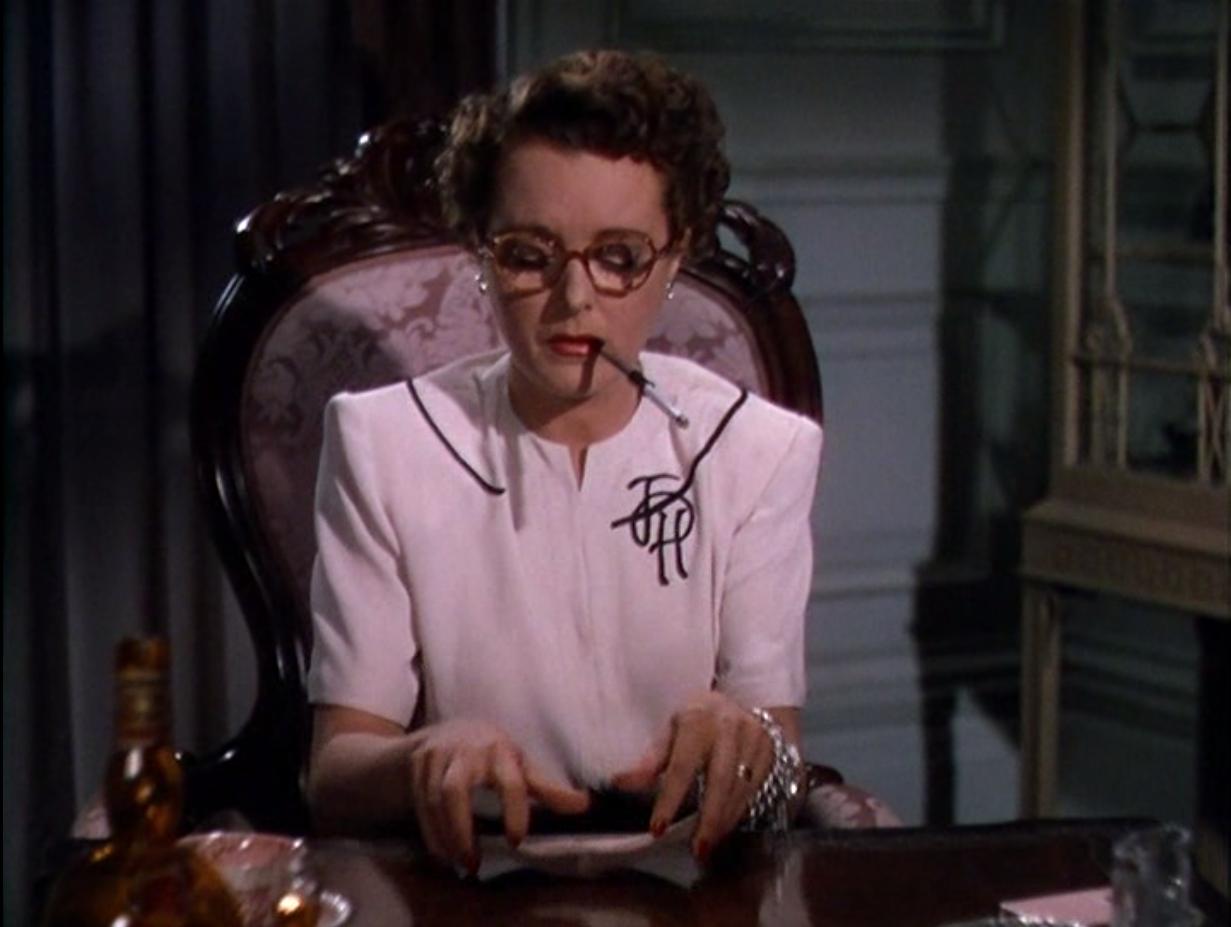
Mary Astor As Fritzi In Desert Fury
Q-Do you have a favourite role featuring Mary Astor?
A-My absolutely favourite Astor role is in “Desert Fury.” She is dynamite in a film that is remembered for little else than her performance. It’s interesting that I always liked it and then I found out from Astor’s daughter Marylyn, that Fritzi, the character in the film Astor plays was—of all Astor’s film roles—the most like her mother in real life. She even wore glasses in one scene which Astor wore all the time unless a photo was being taken and then she took them off. And it was the same in front of the movie camera. Off came the glasses.
.

.Q-And is it true that she and Bette Davis worked on the dialogue of The Great Lie to help make it better?
A-This is excerpted from the Great lie section of the piece I wrote about Astor’s and her best screen performances.
Davis brought Astor into the project because Astor could play the piano and had proven that she could act the royal “bitch” two years earlier in “Midnight”. The only problem was the script. In Davis words it was “junk” so Davis and Astor rewrote it, beefing up Astor’s part and, by making it showier, intensified the rivalry between the two women. For example, the Nevada scenes were written almost entirely by the two women.
Consequently, Astor infused Sondra with many of her own personality traits and psychological issues. Like Sondra Astor presented herself to the world as a self-assured woman and like Sondra used work to cope with her personal demons. Astor would later write that she didn’t really need to act the part, just play it. In this respect, there is a very telling scene early in the film. Brent rejects Sondra. He leaves and Sondra walks to her Piano. In one quick angry movement, she flings off the piano’s cloth cover, lifts up the piano lid, sits at the keyboard and after yanking off her rings, drops them on the piano and begins to play. It is obvious that Sondra is using her music to cope with deep seated feelings of inadequacy much as (If you know her life story) Mary Astor used acting.
This is amplified in the Nevada sequences when, without her work to cope—Sondra’s life now controlled by the Davis’ character—Astor brings Sondra’s inner workings to life with deft artistry. Even the casual viewer can now see that Sandra isn’t really strong but, instead, merely determined. In these scenes the chemistry between Astor and Davis is extraordinary. Astor wrote that the two characters, are like “a couple of cats who had to shield their claws for expediency.”
It is in the kitchen scene—Sondra is caught eating pickles—where Sondra is finally revealed for what she is, an emotional child. Initially shouting her protest at being told what to eat, Sondra suddenly breaks down in a flood of tears. From beginning to end Astor brings absolute authenticity to these emotions. Then, following a storm when the two are playing double solitaire, a frightened Sondra suddenly turns hysterical culminating in the famous slapping scene with Bette Davis.
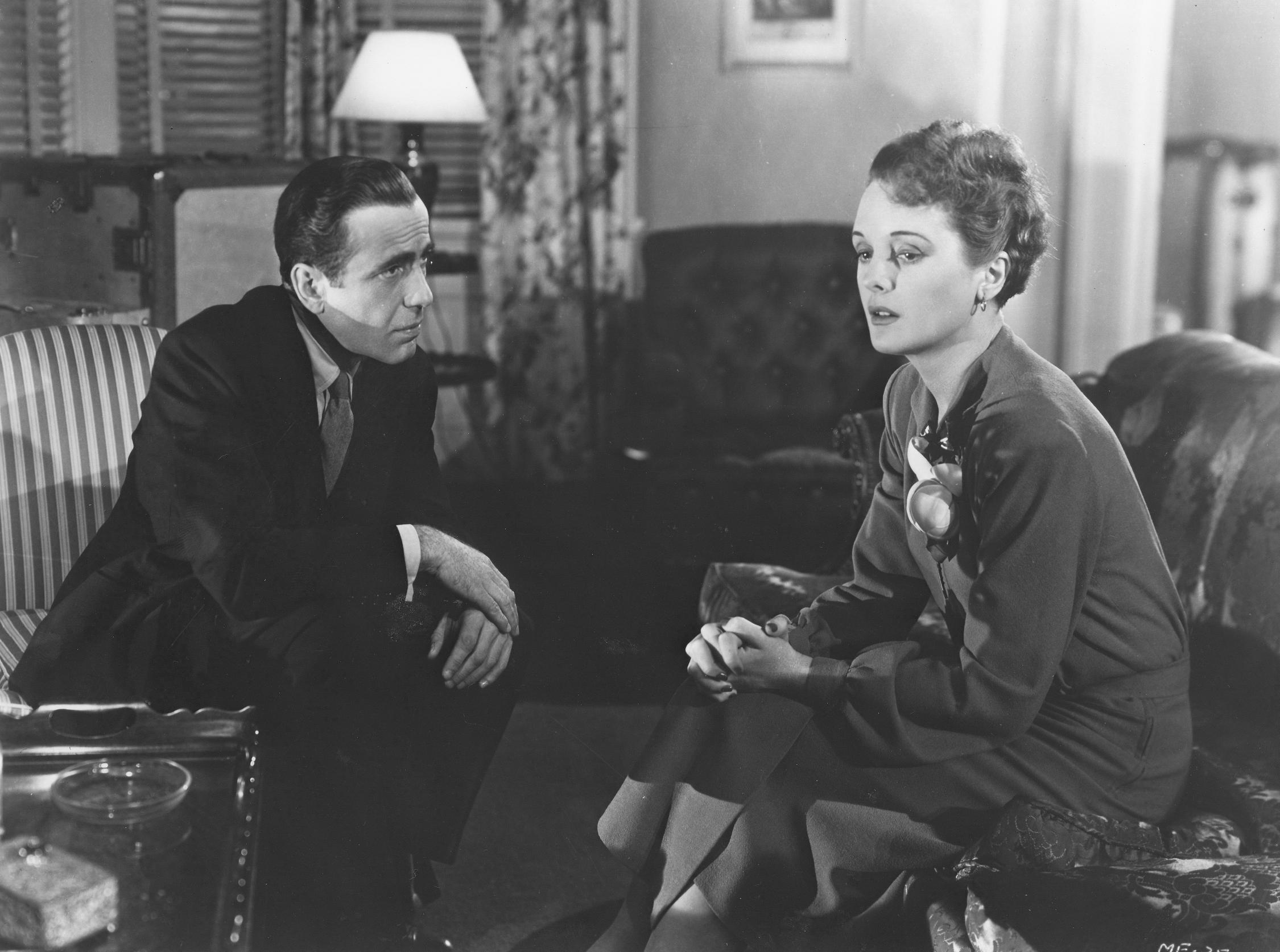
Q-I was wondering if there was talk in 1941 about nominating her as Best Actress for “The Maltese Falcon’ as well as Supporting Actress for “The Great Lie?”
A-I never heard or read about that. It should be understood that “Maltese Falcon” was considered an OK movie at the time of its release but gained its incredible following over the years helped by the Bogie cult in the 1950s. On the other hand “The Great Lie” displayed a Mary Astor no one had ever seen before and she accomplished the amazing feat of outshining Bette Davis in scene after seen. That just didn’t happen. When Astor is on screen you don’t even see Davis. Now, it should be understood that Davis helped this happen as she thought that it would be best for the film. I believe that Astor’s performances—and especially her appearing to be “playing” the piano so effectively on screen—was a surprise to everyone in Hollywood and thus the reason why she won the award. In later years Astor would have preferred Maltese Falcon but in truth that type of genre film rarely wins awards although in time they are thought to be the best films to come out of Hollywood.
Q- Mary Astor’s acting range was exceptional, but I suspect that she may have been hyper-critical of herself. How did a mature Mary Astor regard her acting over the years?
A-She thought most of early rolls were forgettable and couldn’t even remember making many of them. This was especially the case with her silent films and especially the films she made during her three year contract with Warner Brothers. This changed after “Dodsworth” and she was very proud of many of her films made afterwards
Q-Aside from John Barrymore, what other actors did she enjoy working with on screen?
A-She liked Bogie and thought him more accomplished than many thought him to be. She thought Claudette Colbert was a very skilled light comedian. She had a high regard for Cagney although they only worked together once. Eddie Robinson of course. She thought Bette Davis was tops. Anne Harding was another. Florence Eldridge. Everett Edward Horton. She had very good words Eileen Heckart and James Dean. She mentions a lot of them in her book A Life In Film which is, in my opinion, one of the very finest books of its kind—the nuts and bolts of film acting during Hollywood’s Golden Age.

Astor In Return To Peyton Place
Q-I know most people identify her with “The Maltese Falcon” (1941) and “The Great Lie” (1941), but “Dodsworth” (1936), “Act of Violence” (1949) and–believe it or not—“Return to Peyton Place” (1961) are among my favourite Astor films. She infused each of these characters with such humanity that they left an indelible impression on me.
A-I am embarrassed to say that but since writing the book I haven’t seen “Return to Peyton Place.” I saw it when I was teen but really don’t remember it. A good friend whose opinion I deeply respect also says that she was good in it as well. I plan to catch it the next time it comes on TCM which is about the only place you kind find vintage films on TV these days. I call it the Museum Of Modern Art of TV. I agree with you about “Act Of Violence” and I included it among her ten best performances.
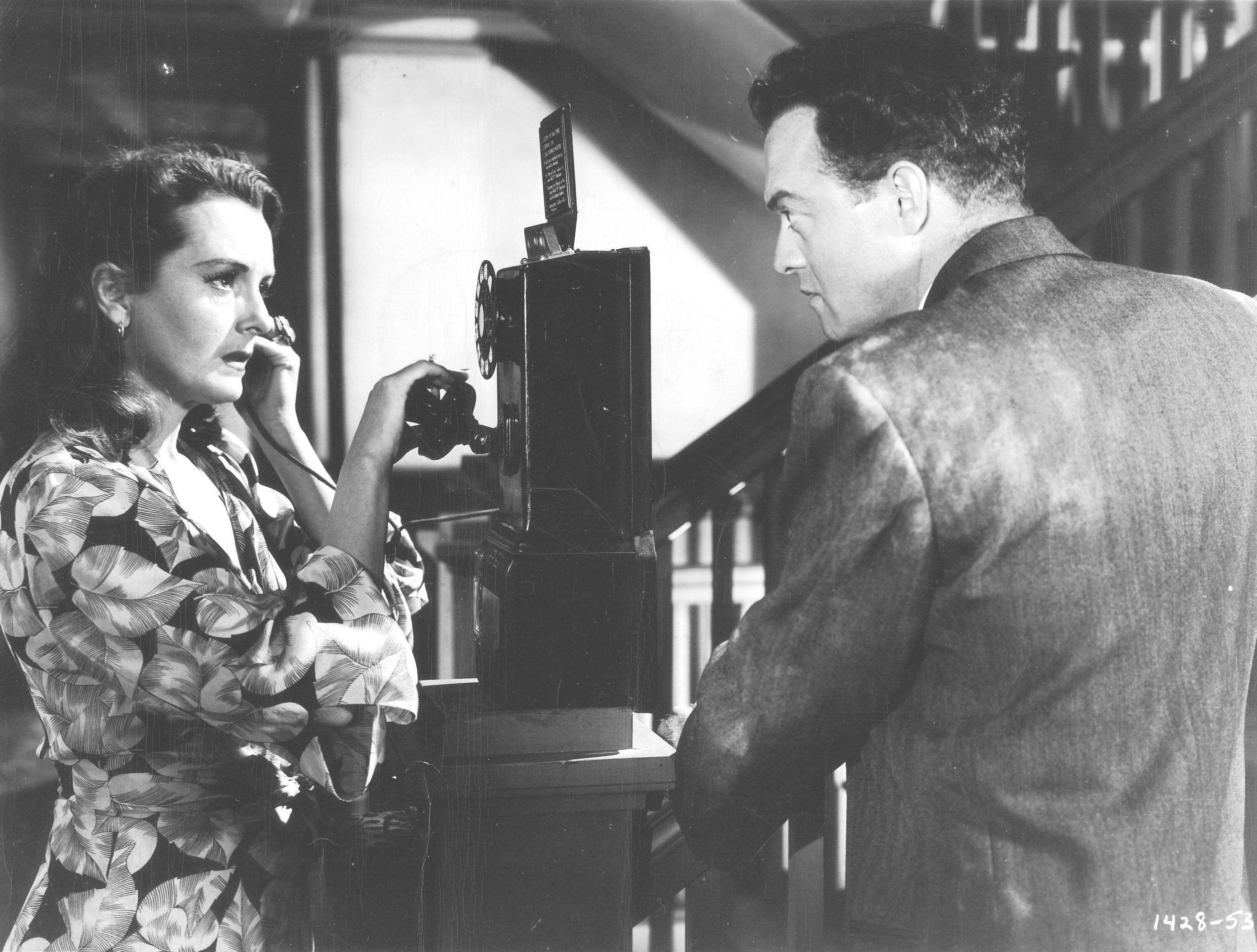
Astor In Act OF Violence
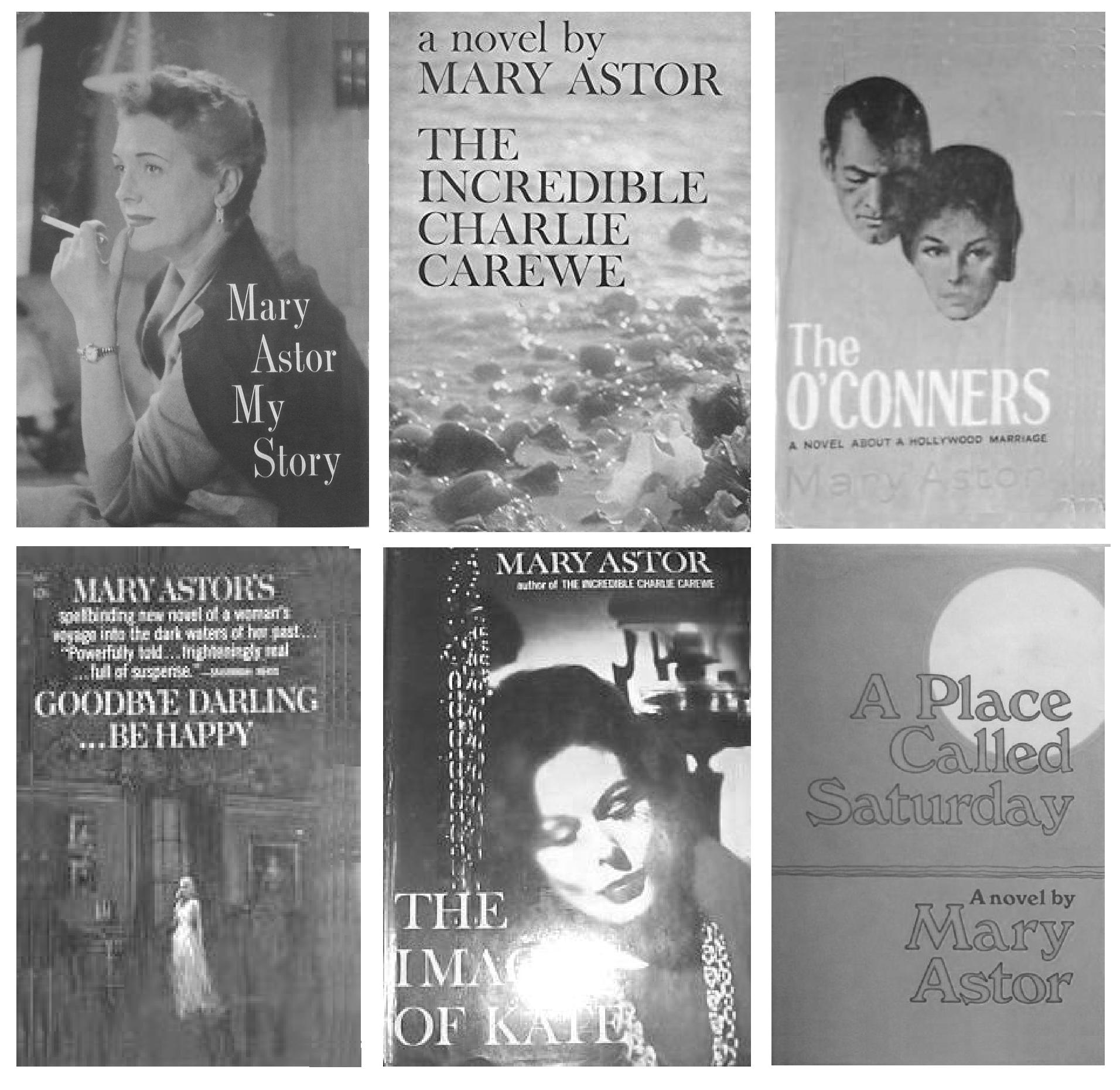
Mary Astor’s Published Books
Q-And how did she respond to her success as a writer?
A-Acting was making a living for her. Writing was what she felt she was meant to do. Astor wrote that seeing her name on the cover of a book meant for more to her than seeing her name on a theatre marquee. Frankly, when she had to make a choice between the two she turned her back on her 45 year acting career and completely devoted herself to writing. You have to understand that Mary Astor was a very, very intelligent woman. Before she began writing and became reclusive, as I mentioned earlier, she enjoyed the company of writers and intellectuals. She detested chatter and her conversation was always intelligent and analytical. She was very proud of her writing, at having—in the latter part of her life—achieved a dream she had had since childhood. It should also be membered that it was when she wasn’t able to write because of illness that she became difficult because I believe that without her writing she felt lost. I understand this because I would feel the same way. All writers do.
Q-I was wondering about your personal reflections concerning Mary Astor’s alcoholism, and when it escalated.
A-As I wrote in the book she began drinking socially in the late 1920s. By the early 40s she had become a heavy drinker–using it to cope and to ease the pain she often felt because of her lack of a sense of her real self-worth. In fact Bogart had commented that the woman could really put it down. Yet Astor was so disciplined that she never drank while making a movie and never but never on the set. During the 40s she also had hidden her drinking so her kids didn’t know about it until the late forties when she was married to her fourth husband who was also a big drinker. By the mid-1940s when she signed with MGM and the parts became less and less demanding she drank in frustration and began to put on weight and middle age took a heavy toll on her looks. The drinking really got bad after she asked to be released from her MGM contract in 1949 as Astor like many artists and performers used work to cope. Without that work the drinking became her main coping tool and got so bad that she had to detox. She was also in a menopausal depression which didn’t help. During the 1950s she joined AA and for the rest of her life battled with her drinking. Sometimes there were long periods where she wasn’t drinking and other times she was. Also, Astor didn’t drink while she wrote. And that was an amazing thing about the woman. She was so disciplined about her work that to do it she could control what is essentially a disease. When she was at the Motion Picture Country Home at the end of her life and, as I mentioned earlier, she could no longer write the dinking became part of her daily routine. It was her only her means to deal with a troubled childhood and a life—on a personal level—that didn’t seem to go the way she would have liked. My own feelings about Alcoholism is that it is a disease that some are more susceptible than others and fortunately it is being seen that way today rather than an example of a weakness of character. I do want to add, that I believe a person should be judged by the best of what they do and with Mary Astor it is her acting and her writing. So, when I think about her the drinking, for me, it is only a peripheral factor.
Q-In her later years did she ever reveal whom she thought to be the love of her life?
A-It was obvious to anyone who really knew her that John Barrymore was the great romantic love of her life. AS I mentioned earlier, she took great pride that such a great man wanted to marry her and she admired the man—even in his decline—enormously and considered him one of the great actors of the period. As I have also mentioned she kept all Barrymore’s telegrams and I have copies.
It’s my opinion, besides her children, the person whom she most loved in the world was her first Husband Kenneth Hawks who had really loved her for herself as she was and in whose hands she felt safe and protected. She was completely and utterly devastated by this death because she had lost a true rock on which she could structure her life and give it meaning. Frankly, I don’t think she ever really recovered as her later marriages demonstrate. It was a profound true love that only Comes once or twice in a lifetime..
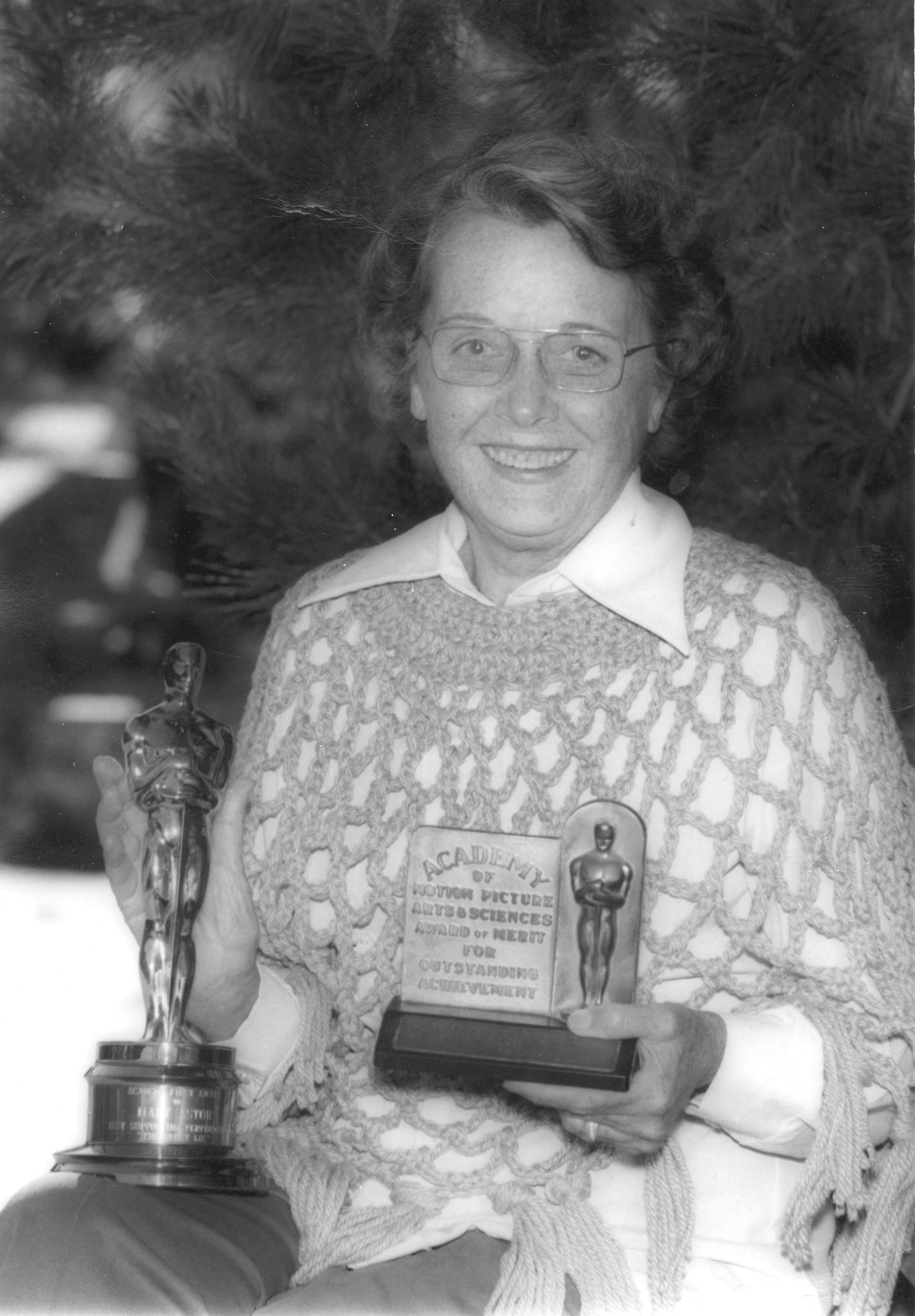
Astor With Her Oscar Original And Replacement While she was Living T the MPCH
Q-Talk about Mary Astor’s final years.
She was living and writing in Mexico when, in the early 70s. she had several slight heart attacks and developed COPD and was forced to return to the States and live with her son until she got recovered. Two years later she moved into the Motion picture Country Home which was and is basically an assisted living facility. She had her own bungalow (as she was paying her own way) and where she could be alone to write. She kept pretty much to herself and as she didn’t like discussing her movies or listening to people complain about their medical problems she didn’t involve herself much with the other residents. In fact she ate alone at her own table and finished her last unpublished novel there. It was also very hard because her friends were dying and this made her feel more and more isolated.
Eventually in the 80s she had several small strokes and things became difficult for her and she was difficult to others. But this should be expected to happen when an independent woman like her begins to weaken and feel that independence slipping away. Family would occasionally visit and her youngest granddaughter by Marylyn who worked nearby would often visit her. Also, Astor had stopped writing and for a woman as active, intellectually and otherwise, this was hard to live with.
She was an avid birder and everyday would feed the birds that flew around her bungalow but other than that there wasn’t really much for her to do except watch her own decline. In 1985s she became very sick and had to be moved to the facilities hospital where she died in her sleep two years later with her son and daughter-in-law at her bedside. Someone had neglected to inform her daughter, Marylyn, of her mother’s impending death so Marylyn wasn’t there at the end but received a phone call from her brother saying, “Mom’s gone.” And that was pretty much the end of a relationship that fifty years earlier had made headlines across the globe.
Q-Do you have another project lined up in the foreseeable future that you can give us some clues about? Or is it top secret?
A-This is the last Movie History I will ever write. In fact the last anything that even resembles a history. I wrote it because of the reasons I have stated above. From now on I am being a memoirist or writing humor. I’ve already have five novels written in the humour style of Donald Westlake which I am ready to submit to my publisher as soon as my agent approves. I can assure you they were much easier to write then The Purple Diaries and lot more fun. I don’t know if readers will like them but I enjoyed writing them and that what matters. I start another book, a memory piece this week if time will allow.
This Q & A in its entirety appears as a reader forum on The Silver Screen Oasis website at:
http://www.silverscreenoasis.com/oasis3/viewtopic.php?f=127&t=6984&p=164715#p164715
